
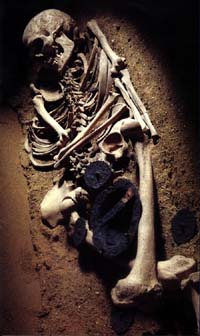 Anglo Saxon remains
Anglo Saxon remains
Westgarth Gardens
Quick links on this page
Saxons take over 442
Arthur leads resistance 470's
Battle of Badon 495
Gildas writes History 538
London and St Albans fall 570
Raedwald rules 599
Sutton Hoo burial 625
King Sigbert sponsors Felix 631
St Audrey's Ely nunnery 673
South Elmham Minster 680
Beowulf written 710
Bede writes History 731
Vikings sack Lindisfarne 793
Foot of Page 855
|
The Anglo-Saxons
and the origins of
The English People
410 - 865
Before
410
|
The text below from 406 to 410 sums up the last years of direct Roman rule over Britain. Please click on the heading if you would like to go back further into the history of Roman Britain before 410.
In 406 the Roman Army was withdrawn from Britain to deal with an invasion into Gaul of the Vandals, Alans and Suevi from across the Rhine. In 407 the Rhine froze over and this gave the Vandals easy access to the wealth and comforts of the Empire. In 409 a major Saxon invasion took place in Britain without the Roman army to repel them. Saxons had raided the East coast early in the 3rd century and from 270 to 285 the Romans had built the Forts of the Saxon shore to cope with the threat. In addition, the Romans had employed some Germanic peoples as mercenaries and settled them in Britain to help with defence. By 410, the country of Britain was being left to maintain itself as best it could, as part of the Empire, but without the Empire's old might and resources to sustain it.
The period which followed has been called the Dark Ages, because there was no longer anybody recording events for the next two or three hundred years.
|
|
410
|
In the year 410, the cities of Britain were officially ordered by the Emperor Honorius to take responsibility for their own defences. In the same year the Goths took Rome and an important result of the collapse of central Roman rule was that no further coinage was imported into Britain. In addition, no coins seem to have been minted in England from 411 to about 630. However, we may judge that existing coinage remained in circulation for some decades, and other coinage would have arrived with foreign traders, even if there was no further official money issued here.
It was the beginning of the end - administrators, specialists and the military could not be supported by the arrival of the official paychest. Other means of survival had to be found.
From 410 to 442, Britain was independent from Rome, and this was to be the last fading age of Romanised Britain before the Saxons were to effectively take over.
|
|
411
|
The Gallic Chronicle of 452 reports a dreadful Saxon raid on the Channel coasts in 411.
In the same year a British Bishop, Fastidius, wrote of magistrates violently killed, some lying unburied, suggesting the violent overthrow of a government by their own people. Constantine's supporters had been overthrown in the recent past, and now that Honorius had washed his hands of Britain, perhaps the Constantine faction had again taken control.
Constantine himself had been elected Emperor in Britain in 403 AD and had then led a military expedition into Spain. In 411 he was taken prisoner in a battle at Arles, and subsequently murdered. Britain's connections with Rome were being severed. No more coins were produced in Constantine's name in Britain, and no more finance flowed into Britain from Rome.
At about this time, the so-called Sicilian Briton developed an advanced egalitarian political philosophy based on Christian principles of the virtues of poverty and the poor and urged abolition of the rich.
In describing the period from about 411 to 425, Gildas wrote that kings were anointed and soon after slain by those who had anointed them, but the people were prosperous.
|
|
418
|
Roman imperial Government outlawed the Pelagian doctrine, but this had no effect in Britain for decades, where it was introduced in 421 by Agricola.
|
|
418
|
Honorius granted federate status to the Visigoths and they settled in Aquitaine. He could not conquer them, so had to live with them, and in practice they became a separate kingdom under the emperor. The Burgundians followed suit with their own kingdom. Independence was breaking out throughout the empire.
|
|
423
|
Back in Rome, Honorius lived until 423, and his dynasty survived when his sisters' son, Valentinian III took over.
|
|
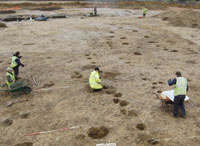
Hertismere School, Eye
|
|
425
|
Vortigern, a Welsh follower of the Pelagian doctrine, is said to have come to power. The north still had its static Roman army installations and many of the forts were still manned for many years later. He immediately faced the threat of further attacks by Picts down the Yorkshire coast, and the Irish in the Severn Valley.
Between May and October 2007, Suffolk County Council Archaeological
Service uncovered a previously unknown Early Anglo-Saxon settlement lying
across 12 acres (4.72ha) earmarked for new playing fields at Hartismere
School in Eye. It had a continental long-house of a type hitherto unknown
in England. It had a very early cremation cemetery which was eventually dated to 425. The site is extensive but only sparsely occupied, with only 18 SFB s found and identified by 2013. However, the area covered makes it the largest early Anglo-Saxon dig ever undertaken. Bronze Age and Iron Age remains were also found here that indicate a very long history of human usage of this area.
The site was on a tributary of the River Dove which confirmed the known preference of the early Anglo-Saxons for the river valleys of East Anglia, over the claylands of more elevated areas.
|
|
428
|
The British appealed to Rome for help to defend themselves, but no help was available.
So the Council met under Vortigern and decided to appeal to the 'Nobles of Anglekin' for aid. They intended to hire some Saxon seamen to defend the coasts just as past Roman emperors had done. The Saxon leaders were Hengest and Horsa, and three keels or ships were sent with them and they were based on the Isle of Thanet. There were probably only a few hundred of them at this time. They were paid by a monthly system of supplies.
|
|
429
|
With papal approval, the Bishops of Gaul sent Bishop Germanus of Auxerre and Lupus of Troyes to Britain to combat the Pelagian heresy of Vortigern and his people. During the Bishops' visit, the pagan Saxons and Picts made a joint campaign against the British, possibly in Wales where they might have joined the locally settled Irish. Bishop Germanus led the army and was said to have had the victory 'without the might of men,' shouts of Allelulia apparently being enough to frighten the Saxons away. This victory led to the establishment of the British Kingdom of Powys.
Notwithstanding this battle with paganism, Germanus found British Christianity still largely orthodox. He visited St Alban's tomb at Verulamium, leaving behind some precious relics, and healed the daughter of a Tribune. Roman ways were continuing in the central and western areas, although we believe that these ways were lost much sooner in the east. This is explained because it was where the Saxons were more numerous, being the first point to be reached from their ports on the Elbe and Weser Rivers.
|
|
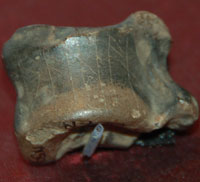
Runic gaming counter |
|
430
|
After a short time the number of Saxons allowed to settle increased and new areas were penetrated. Very early remains have been found at Caistor by Norwich, Luton and Abingdon. This roe deer foot bone was excavated at Caistor by Norwich, and was used as a gaming counter. The runic inscription indicates that it was of north german origin, showing evidence of the new language penetrating British life. The runes spell "raihan", meaning roe deer, and such cryptic inscriptions typify the earliest runes found in this country. This small piece of bone may, in fact, carry the earliest known use of runes in Britain.
These were strategic defensive settlements, established to protect the Cotswold heartlands, and Norfolk was particularly well settled. Because the north still had the army in place, there was less need for reinforcements to be sent there. Forces were placed to protect the North road, the Thames estuary and the major intersections of the Icknield Way. These inland posts were really a defence line of last resort.
One of these posts might have been at West Stow, sitting on the River Lark crossing of the Icknield Way.
A sprawling half mile long Romano-British settlement known as Camborito had been long established at adjacent Icklingham, and a Roman villa has also been identified there. Finds have been made here over many years and four lead water tanks have now been discovered in Icklingham bearing Christian symbols. In 1974 an apparently Christian cemetery was found with a possible Christian chapel.
Around this time it thus appears that the Anglo-Saxon village Stowa was first established just the other side of the Icknield Way from Camborito. How they interacted and how relations changed over the next 50 years we do not know. The Romano-British were Christian at this time and the Anglo-Saxons were pagans.
In the east and south, Germanic forces were accepted nearly everywhere, with the exception of Verulamium, the capital of the Catevellauni.
In the absence of a Pictish or Irish attack, the Kentish Chronicle reported that Hengest and Vortigern invited reinforcements under Octha to bring 40 ships over to attack the Picts on their own territory. They plundered the Orkneys and then settled in North Northumberland. They may have founded Dumfries - the home of the Friesians. Scotland never tried to invade England again until 1745.
|
|
431
|
The Pope sent Palladius to Britain to convert the Irish but he returned after a few months and died.
|
|
432
|
Palladius was replaced by Patrick, a British monk trained in Germanus' monastery, and later to become St Patrick.
|
|
433
|
The Irish Annals record the first Saxon raid on Ireland which could have been Hengest's warning to leave Britain alone, now it was protected by him. Equally this may have been other Saxons, not under Hengest, continuing their old ways, but they would be a long way from friendly harbours. In any event, the Irish ceased to be a problem until the end of the century.
St Patrick also succeeded in getting the Irish to accept the Roman religion of Christianity. It could be that the Bishops should again be credited with a bloodless victory, this time over the Irish.
|
|
430's
|
Cunedda, or Kenneth of the Votadini, now led a move into Wales from the North of Hadrians Wall, and expelled he Irish settlers with enormous slaughter while the Irish kings stood neutral. This action probably occupied the next 80 years.
Similarly the Cornovii were moved into Devon and Cornwall to expel Irish settlers in those areas.
|
|
437
|
By these means, Vortigern produced a prosperous Britain, with secure borders, only to be overthrown by civil war when Ambrosius saw his chance. With peace, the taxpayers began to refuse to pay for the Saxon defence and the Council tried to send them home.
In 437 it appears there was a battle between Ambrosius and Vortigern possibly at Wallop in Hampshire.
Vortigern had to rely on bringing in a further 19 ships of Saxon reinforcements to defend himself against Ambrosius. They seem to have been settled, together with later arrivals, in and around Canterbury and East Kent.
|
|
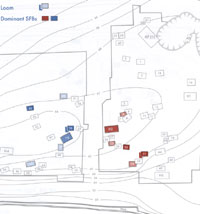
Two family groups at West Stow |
|
440
|
In his book "West Stow Revisited" (2001) Dr Stanley West explained his views of the chronology of buildings at West Stow. He believed that from c440 AD to c480 AD there were these two family groups of buildings located at the site at West Stow. The buildings marked in blue were located around the hall which he referred to as H3. The dwellings marked in red were associated around hall reference H2. The dwellings marked in red on the plan are basically in the area where the reconstructed village was built in the years after 1973. The gap between the two groups has not been excavated because of the 19th century tree belt which now bisects the knoll on which the village stood.
Contour lines outline the knoll on which the village stood. The whole settlement would extend to about 5 acres over its two centuries of existence, and the knoll stood at up to 15 feet above the surrounding ground level.
|
|
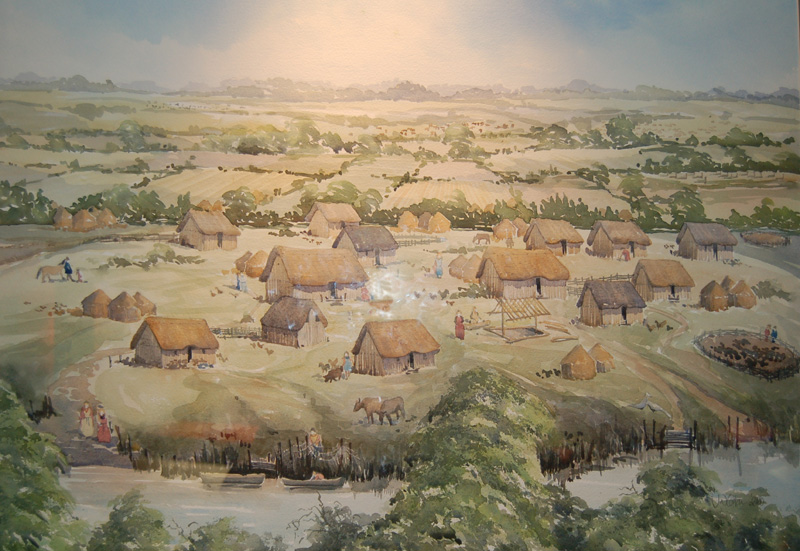
Anglo Saxon Village |
|
blank |
By 440 we believe that the village at West Stow was now well under occupation by the early Anglo-Saxon settlers.
What was it like here when the Anglo-Saxons arrived? There was a 'managed' landscape with Romano-British field systems; grazing for sheep on higher ground, water meadows and arable land all rather run down, as the economy collapsed.
Useful timber for building was to hand, and there were deserted sites, like the Icklingham Roman town nearby, where all kinds of useful things could be found and recycled such as tiles for hearths, bronze, iron and even bits of pottery.
It is believed that many of the Romano-British population survived the collapse of Roman Britain and were absorbed into early Anglo-Saxon society, some at least, as slaves.
There were no forests of pine trees - these are all 19th-20th Century plantations.
From about 440 AD for the next 200 years into the 7th Century the landscape in our area was settled by the Anglo-Saxons, whose little villages controlled areas of land which were to become the 'parishes' of later saxon and medieval times.
West Stow, sitting in the centre of the Lark Valley, was one of a number of similar 'villages' extending from the three round the later Bury St Edmunds to Mildenhall on the fen edge. The Blackbourn valley to the north-east has a similar distribution of sites. They are spaced out along the river banks with territories extending behind. Beyond these settled valleys, central Suffolk, a region of heavy, damp clay was returning to dense scrub and forest after the collapse of Roman settlement. This area was not occupied by the earliest Anglo-Saxon settlers. To the east, settlement penetrated the lighter sandlings of the coastal region much as in the west. To the west and south the river systems of Cambridgeshire were densely settled by Anglo-Saxons and were clearly related by their possessions to those in Suffolk.
Connections were maintained with the continent and Scandinavia with the import of articles of dress and fashion as well as technologies and art.
|
|

Anglo Saxon 'keel' |
|
442
|
More and more boats were arriving from the Continent. There was pressure on the Saxon's homelands from new settlers from Denmark and Holstein, and flooding from the rising sea levels. One such boat, constructed of larchwood, was found buried at Ashby Dell in Suffolk in 1830, a few miles from Burgh Castle. It may have arrived there at a time when the valley was actually a waterway, for sealevel was rising during the 5th century. Its construction is similar to the Nydam boat, excavated in Denmark. A reproduction of the Nydam vessel is shown here.
Hengest's Saxon forces had now increased to such a level that resentment over their spread and their pay rose high on both sides. Hengest demanded more money and more land for his growing forces. Whatever happened, it became a fight and armed Saxon insurrection swept across the lowlands. Vortigern was first driven out of Kent by Hengest.
Later, Caistor by Norwich for example, was totally destroyed as undoubtedly were other settlements, and Colchester was stormed. The economy was also destroyed. The pottery industry ceased production. Farms ceased to produce food, and markets ceased to operate. Certainly Kent and East Anglia were conquered in this first attack. Over the next twenty years conflict would continue between the Roman Britons and the new English peoples. As Britain passed into Saxon control, it would end with much of the Southern British people emigrating to Gaul in the 460's.
|
|
446
|
The Romano-British appealed for help to Gaul, the great General Aetius, and said they were being pushed out by barbarians, and also suffering from widespread flooding. This letter has been called "The Groans of the British". The Saxons attacked right across to the West, but appeared to withdraw to their eastern settlements again after great destruction of the economy.
Aetius provided no help, but Bishop Germanus visited the British for a second time, so we can envisage the country more or less partitioned into Saxon control and old British control with a largely Romanised flavour. Germanus was still attacking the Pelagian heresy, including Vortigern himself by this time, so Vortigern's grip was now loosened and other local rulers had set themselves up in the British areas.
|
|
449
|
This is the year in which Bede placed the invitation of the Saxons to settle in return for defence of Britain. He also condensed most of the story from 428 to 449 into this one year, probably based on his reading of Gildas. In any event, it is still a pretty accurate date by which the Saxons had taken over much of the country.
|
|
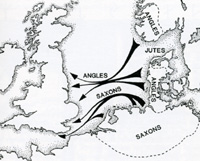
Anglo Saxon settlers |
|
450
|
For the next hundred years it seems likely that more settlers from northern Europe moved into Britain. These people did not use coinage as money, but often collected coins made in Gaul, Spain or Italy. By 450 the continent had abandoned silver and bronze as coinage, and all coins were now being made of gold. These were the 4.5 gramme solidus and the 1.3 gramme tremissis, which was worth one-third of a solidus. These coins were also brought into Britain, but were more often than not pierced and used as jewellery. Not until about 575 would the Anglo-Saxons start to use coins as money and a medium of exchange.
How long after the Romans left before the Anglo-Saxons began to settle around Haverhill is not, as yet, possible to determine but we do know where they started; not on the more agreeable south-eastern slope of the main valley, but at the head of the smaller one. The reason was probably that this was a better defensive position. The name Burton means 'the farm by the fort'. So it was at what is now Burton End that they built their fortified farm, on the place which is now called the 'Castle'.
It is thought that the crossroads where Clements Lane crosses Camps Road into Crowland Road probably formed the centre of the Saxon town. The Church stood on this junction to the north-west of the Burton End side.
|
|
452
|
Around this time the British launched a counter-attack upon the Saxon encroachments.
Vortigern's son, Vortimer, was said by the Kentish Chronicle to have driven the Saxons out of Kent and back to Thanet for five years. The main battle seems to have been at Richborough.
The British also won at the Battle of Aylsford, but at Crayford the Saxons won and drove the British out of Kent, back to London.
The Saxons now "summon keels full of vast numbers of warriors" to give reinforcements in what was to become full scale warfare.
|
|
455
|
The British King Vortigern and the Saxons agreed to meet to consider making peace on existing boundaries. Vortigern had lost any authority over the western areas and was too weak to fight the Saxons without total national support and resources. So Vortigern and 300 elders of his Council held a peace conference with Hengest. The Saxons killed them all, except the King, at the table. He was forced to give them Sussex and Essex in return for his life.
|
|
455
|
Back in Rome, Valentinian III was murdered a year after he had murdered General Aetius, and with him died the prestige of his dynasty.
The King of the Vandals, called Genseric, now entered Rome and for two weeks stripped it of all its treasure, carrying it off to North Africa.
This event is generally reckoned as signifying the final fall of the western Roman empire and it "had no strength to rise again." Britain could expect nothing more from Rome, and its only hope for help against the Saxon invaders was to appeal to Gaul.
|
|
458
|
From their bases in Kent, Norfolk and the Cambridge-Newmarket region the Saxons attacked the rest of Britain in a great raid as far as Wales. London remained in British hands. By now, many Saxon villages were at least 20 years old and the young men were born in this country and were in effect fighting for their homes and families, not considering themselves invaders.
|
|
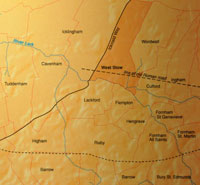
Parishes on River Lark |
|
460
|
The Lark, Blackbourne and Ouse valleys of West Suffolk had been settled by these mixed Angles, Saxons and Friesians by this time, including at West Stow. The village at West Stow was extensively excavated by Dr Stanley West from 1965 until 1972 as the site was under threat from the advancing landfill site established on the former West Stow Sewage Works. In 1973 a programme of reconstruction of some of the buildings of the original village was begun. By 1979 the landfill site was landscaped over, and this experimental reconstruction has continued ever since. An Anglo-Saxon Study Centre has been established next to the reconstructed village which is now included within West Stow Country Park. The West Stow Anglo - Saxon Village is fully explored in this appendix to this Chronicle:
The Anglo-Saxons in St Edmundsbury
The village of Stowa, as we call it today, was located on a small hillock by the River Lark, on very light sandy soil. The Icknield Way crossed the River Lark at a ford a few yards away, running roughly north and southwards. An old Roman road ran east and westwards a few yards north of the village. This road led to the old Romano British village of Camborito, just a few hundred yards to the west. The village cemetery was just across the Roman road.
At first the people of Stowa were cremated when they died and it is estimated that a thousand cremations were held here, of which about 530 were contained in funerary urns.
The Central Suffolk clay soils do not seem to have attracted the Anglo-Saxons. They preferred the river valleys, and more easily worked soils. Other settlements have been excavated at Honington and Grimstone End in Pakenham. We do not know exactly when Bury or Haverhill were first settled by Anglo-Saxons, but we have a better idea of where it took place. In Haverhill the first settlement was at Burton End. In modern Bury we have evidence of several Anglo-Saxon cemeteries, so there were probably at least four small villages within the area of today's town. One was probably where the Abbey's ruins remain today, one near Barons Road, one at Westgarth Gardens and one near Northumberland Avenue.
It seems that the settlers in West Suffolk were based along the river valleys which flowed into the Fens, and that they looked to trade in that direction rather than to the east. It seems likely that West suffolk was thus settled from the direction of the Wash, through the Fens, while East Suffolk was settled up the river valleys like the Gipping, Stour and Waveney, which all flowed eastwards towards the North Sea.
These early Saxon settlements in West Suffolk divided up the land in a way which is believed to be reflected in the much later ecclesiastical parishes. In many places they seemed to have adopted boundaries already in place from earlier times.
|
|
460's
|
Much of the British forces now emigrated to Armorica, later to become known as Brittany. They were not just fleeing the Saxons, they were joining the still Romanised dominions of Aegidius, who needed help to defend Gaul and themselves against the pagan Saxons.
They were given lands North of the Loire and the place name Bretteville is still widespread today in Normandy. These people looked on themselves as Roman provincials and had little difficulty moving from one part of the old empire to another. They were well educated and Gildas complains that all the books were taken out of Britain with them. They made a fighting force of about 12,000 to reinforce Aegidius.
|
|
460's
|
Despite the emigrations to Gaul, the Roman Britons continued to resist the English spread, perhaps up to about 495.
Although Vortigern had ceded Sussex, it was not taken unopposed. Aelle landed at Selsey Bill to take Chichester but was thwarted. London, Chichester and Verulamium were still in British hands but 12,000 troops had gone to Armorica so a decisive counter attack was ruled out. However, various local leaders or Kings took various offensive actions to avoid their own total destruction. Ambrosius Aurelianus, perhaps one of the last of the aristocratic Roman nobility to survive, was a central British figure of these battles. Ambrosius led the resistance for the early years of this 30 or 35 years action.
|
|
476
|
In Rome, Odovacer discontinued the nomination of western Roman Emperors, and turned to Constantinople.
|
|
470's
|
Ambrosius Aurelianus was succeeded as the main leader of the surviving Romano-Britons by Artorius, another man of Roman family, known to us today as King Arthur. This is the real period of Arthur, a relic of the fallen Roman Empire, hanging on against the Saxons constantly encroaching from their new homelands in East Anglia. The British retained a knowledge of literacy, and of Christianity, whereas the Saxons must have seemed totally alien, with their pagan practices, and contempt for books and the ways of "civilisation". This scene must have been very different from the romance of Knights in shining armour which arose in Medieval story telling, maybe 600 to 700 years later.
It seems likely that British resistance in 470 was based on the wealthy farmlands of the Cotswold area, Salisbury Plain and in Hampshire. It is also highly possible that they based their tactics upon the use of horses and mounted cavalry. This knowledge may have been remembered from Roman days, or invented by necessity, but their armour and weapons would be have been Roman. The Saxons at this time invariably fought with spears on foot, and this helps to explain how the weakened British managed to resist them for so long. Using mounted men in hit and run attacks, they could also cover large amounts of territory at five times the speed of the Saxons. It has been suggested that as the Romano-British did not use stirrups, they could not fight from horseback, but we now know that a saddle can be designed to work without stirrups.
The British cavalry needed secure overnight stops and used the old Roman walled towns, or re-occupied some of the old iron-age hill forts like South Cadbury.
Battles were fought in a zone from Wiltshire and the borders of Gloucestershire up to the Cambridge area. There is no evidence of fighting in the Saxon/English heartlands of Norfolk and North Suffolk or Kent.
The British resistance inspired a new sense of local identity, no longer Roman. They called themselves Combrogi or 'fellow countrymen', whose modern form is Cymry or Cumbri, names which survive today in Wales and Cumbria.
The English knew them by both names, and also called them foreigners or wealh or wylisc in Old English, and Welsh in today's English. The English saw them as part of the old Christian world, based on Rome.
The Anglo-Saxons named their country Englaland (land of the Angles) and their language was called Englisc. It is the modern historian who refers to them as Anglo-Saxons, who spoke Anglo-Saxon or Old English. Suffolk is full of Anglo-Saxon place names, most names coming from Old English words.
Latin writers referred to them as Angli and were doing so before the middle of the 6th century. By the 7th century King Ine called himself King of the West Saxons but described his subjects as Englishmen or Welshmen, but not as Saxons.
Saxon was a term used by foreigners, and survives in modern Welsh as Saesnag and in Irish as Sasenach. Until about 650, the Saxons were Pagan, also called Heathens or Barbarians.
Latin was still the written language of the British, although the need for it rapidly diminished as contact with the Empire declined.
|
|
480
|
At about 480 Cerdic was commander of Saxons in the Winchester - Southampton area. They fought in the Battle of Portsmouth Harbour against Arthur and the British. This was probably at Portchester, the most westerly of the old Saxon-shore forts. The battle seems to have had no decisive outcome.
The flow of immigrants much increased in the late 5th century, to such an extent that the homeland of Angeln was deserted in Schleswig. At this time we believe that the Kings and their courts also moved to England.
In the Ipswich area a group arrived with a strong Scandinavian background, and Danish traces are recognisable in the archaeology of Kent.
|
|
486
|
In Gaul, King Clovis of the Franks killed Syagrius and took over his kingdom. By 507 he drove the Goths out of Aquitaine and occupied Bohemia setting up the framework of France, land of the Franks.
|
|
488
|
In 488 the South Saxons became ruled by Aesc, who inherited the leadership from Hengist. In 491 he led an attack on the old Roman fort at Pevensey, and massacred its entire garrison. Meanwhile Cerdic and Cynric were founding a West Saxon dynasty.
|
|
490's
|
London and its surroundings remained a British stronghold separating the Saxons of Kent from those in East Anglia. This situation seems to have persisted up to 568.
The Saxons themselves were not a homogeneous group. Differing grave goods found in their cemeteries indicate that some settlements contained markedly different cultural backgrounds from others, even when comparatively close to each other. For example, at Haslingfield, a village in sight of Cambridge, these people seem to have had no contacts with Cambridge Saxons. Others of their kind have been found in the Middle Thames area. The Eslinga Saxons may thus have been allies of the British at this time.
|
|
495
|
The final battle of this era was the Battle of Badon Hill (Mons Badonicus according to Gildas). The English King Aelle led the Saxons from Kent, Sussex and Wessex and seems to have advanced westward to attack British cavalry bases. Badon may be at or near today's Bath such as Solsbury Hill by Batheaston, but its exact site is unknown and hotly disputed. According to Nennius, there was a 3 day siege which ended when King Arthur led a charge and killed 960 Saxons. Following victory at the Battle of Badon, won by the British, peace lasted for 75 years.
The difficulty of establishing accurate dating in the 'Dark Ages' is shown by this battle, which some historians date to 516 or 518. It is best thought of as occuring shortly before or after the year 500.
|
|
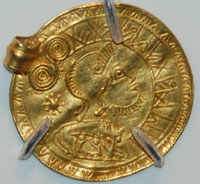
Gold pendant from Undley |
|
500
|
By now the war in England had been fought to a standstill, with partition of territory being an established fact. Eastern England, and East Anglia in particular, was firmly held in Saxon and Angle hands.
Trade and social contacts were probably maintained with their homelands, as shown by many of the objects that have been found. At Undley, near Lakenheath, a high status Angle wore this gold pendant shown here. It was made in the late 5th century in Schleswig or southern Scandinavia. A roman helmeted head copies many Roman coins, and although the wolf and infants is a strong Roman motif, there are also runic characters present. Such a pendant, made from a pattern stamped into flattened gold, is known as a bracteate.
This object illustrates one of the earliest known examples of runes seen in England. Literacy under the Romans had used the latin alphabet still familiar to us today. The northern German tribes had adopted a runic alphabet, known to us as the "futhark", by the 3rd century AD. This object helps to illustrate their linguistic and cultural penetration into eastern Britain at this time.
Although the British had stemmed the English advance further westwards, the Roman Empire had faded around them, and they had no larger continental Empire to support them. The Romanised economy was destroyed by war, and the British had to rebuild their lives in their own way, with only half the country's resources available to them.
In the Fens the Roman drainage system built around Car Dyke had failed as there was no administration to maintain it against the rising sea levels. Areas of Fen now flooded, leaving only Ely and a few other islands above the water level. Along with this problem came a rise in sea levels through the 4th and 5th centuries, so that by this time East Anglia was a virtual isthmus, cut off from the area of Mercia to the West by the great marshy fenland.
To the south the heavy clay soils of the Stour valley were reverting to Wildwood. The Roman roads were becoming overgrown by impenetrable blackthorn thickets by a lack of use and maintenance. Rome's once great city at Colchester declined into a ghost town by the 6th century, and both Colchester and the area of North Essex would be sparsely populated until the coming of the Danes in the 10th century.
However, for the next 15 years this period was peaceful and was looked on as a golden age of freedom, truth and justice under King Arthur, by Romanised scholars like Gildas. As the Saxons themselves kept no written records their views of the situation are unknown. Welsh poems and later monastic traditions regarded Arthur as a tyrant. Gildas never named Arthur, and the modern legends surrounding King Arthur did not begin until first taken up in Norman France in the 12th century by Chretien de Troyes. The story was taken up by Geoffrey of Monmouth in England shortly afterwards, and Malory's Morte d'Arthur followed in the 15th century.
Arthur continued to experience conflicts such as at Chester and various boarder actions against the Irish in the north west, and in Wales and Cornwall and possibly local rebellions by British war lords. His success led to him being called Emperor and Roman titles and governorships were somewhat restored in the area under his control, based on lowland central England.
There is some evidence that Saxon settlements which were on the fringes of Saxon control, like Kempston by Bedford, were sent packing by Arthur, establishing stricter borders between both populations. Following years of bloodshed and flight to Gaul, it appears that the population in 500 was only a small fraction of what it had been in the Roman period by 400 AD.
Arthur probably held court in each of his cities, such as Chester, York, Gloucester and Colchester. The British name for Colchester was Camulodunum, a possible source for Camalot or Camelot as it is now spelt.
|
|
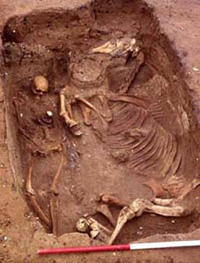
Anglo Saxon horse burial |
|
510
|
Around 510 a Saxon nobleman was buried with his horse at Eriswell. The site was discovered in 1997 under a baseball pitch scheduled for redevelopment on the USAF base at RAF Lakenheath. Some 200 graves were located on the site, spanning a period of 150 years. This is now a completely different form of burial than the earlier cremations exemplified at West Stow.
Over the next 5 years more graves were discovered. Eriswell had three cemeteries with 446 graves finally identified. This is a major find for East Anglia and covers the 200 year period from the late 5th to early 7th centuries. There were other horse burials found, but the first one in 1997 aroused the most excitement.
Although the remains were originally dated to around 550AD, a radio carbon date was obtained in the early 21st century which placed the first horse burial burial to between 490 and 535AD. I have therefore located it at roughly the midpoint of this range for the purposes of this Chronicle.
The first such horse burial to have been discovered may well have been at Witnesham, near Ipswich, in 1820. This was on the land of the Reverend C Eade of Metfield, farmed by Charles Poppy. The body had a lance and helmet, and the horse had full saddle and harness.
|
|
515
|
King Arthur died at the Battle of Camlann according to the Cambrian Annals. The location of this and its causes remain unknown, but there was no one to take his place as overall Emperor. He was almost the last remainder of the western Roman Empire, outliving even Rome. Some historians date this battle to 537 or 539.
|
|
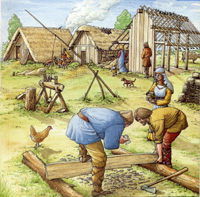
6th century village life |
|
525
|
By this time it would appear that local tyrants were carving out their own territories, and the generals were growing in power and usurping local government and the judges. This was all in the non-Saxon areas, and we know about it from Gildas.
After this date a further wave of settlers came to East Anglia and Kent from Sweden via Denmark and Friesland. If it was around this time they may have been led by Wehha, because the first King of East Anglia was Wehha according to Nennius, a 9th Century historian.
In 525, the Anno Domini system of dating was invented by Dionysius Exiguus, a Scythian monk living in Italy. This system would be irrelevant in Saxon England until Christianity reappeared after 630.
|
|
538
|
Around the year 538, Gildas wrote his 'complaining book', which was an attack on the princes and bishops of his day. He tried to look at history to find the origins of the evils he perceived. Gildas was born in the kingdom of the Clyde but was taken south to the shores of the Severn Sea and was taught in the old Roman educational tradition. Gildas tried to explain why the British were being punished by being occupied by Anglo-Saxons and why they deserved this fate. Much of recorded history from 440 to 540 relies upon the work of Gildas, and Bede in 731 repeated Gildas' history. However, it is now thought that from 449 onwards, his dates are about 20 years later than reality.
|
|
540
|
If there were new settlers at this time they presumably were led by Wuffa who would have been the second King after Wehha. He sailed up the Deben to found Ufford and the Wuffinga dynasty. These people had a considerable impact despite the fact they were preceded by 100 years of continental settlement. With a strong maritime tradition they practised ship burials at Sutton Hoo, Snape and Ashby. The descendant royal family is known as the Wuffings or Wuffinga. The dynasty is thought to have continued with Tyttla, and then to Raedwald, the most famous and greatest of them.
The area later known as the Wicklaw, and later as the Liberty of St Etheldreda, may have been the home estates first established by the Wuffing kings. It covers all their major sites from Rendlesham to Sutton Hoo, and the estuaries of the Deben and Alde and south to the Orwell.
By now East Anglia seems to have become one cohesive kingdom. A strong king would be welcome to impose order in the land and to create the stability without which the farmers could not till the land successfully.
In these early times the King would have lived off the proceeds of his own estates. In addition, there arose a system called "food rent" or "feorm", whereby the King was supplied with food and provisions by each group of settlements in some agreed form. This may have arisen as the King moved his entourage around his kingdom, perhaps spending periods at designated royal "vills" or settlements. In the absence of money, these food rents were paid as real provisions. Each settlement also owed their lord a variety of services, mainly a mixture of agricultural and military duties.
|
|
541
|
Dendrochronology is the science surrounding tree rings. By examining the rings which indicate each year's growth we can
identify periods in which trees grew very little or not at all. This is
indicated by clusters of extremely narrow rings, which suggest
extremely cold growing seasons. A band of these narrow rings occurred
after A.D. 540 and lasted about six years in parts of Europe, Asia, and
North America.
It has been suggested by Michael Baillie, Professor of
Palaeoecology at Queen's University, Belfast, that these periods may have been caused by comets or planetary debris which throw dust into the atmosphere, thus causing several cold years, as the sunlight is reduced at the earth's surface.
Exact dating of these early events is difficult and dates get continually adjusted in the light of further evidence.
On 20th November, 2018, the Times newspaper reported the work of Michael McCormick of Harvard University who dated this disaster to 536 AD, based upon the works of Byzantine scholar Procopius. Procopius wrote, "The sun gave forth its light without brightness, like the moon, during this whole year". Irish chronicles noted " a failure of bread from the years 536 - 539. In 541 Bubonic plague killed up to half the population of the eastern Roman Empire. Harvard scholars have linked these events to a volcanic eruption in Iceland that spread a high level layer of ash around the globe. Two more eruptions occurred in 540 and 547. It is suggested that these events caused economic stagnation across Europe lasting for a century.
|
|
547
|
A severe epidemic, possibly of Bubonic Plague, spread in Britain, and seems to have lasted until 551. This was called the Yellow Plague, which spread thoughout most of the known world, killing millions of people.
|
|
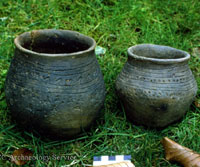
Pots from graves Eriswell |
|
550
|
These hand-made,highly decorated urns are typical of sixth century pottery in England. They were made on a small scale and fired in clamps. These early Anglo-Saxon urns were excavated at Eriswell Anglo-Saxon cemetery. They were not cremation urns, but seem to be grave goods which possibly held food or drink for the afterlife. No kilns were found on site, and many pots have potters' stamps which are also known from West Stow, Lackford and Spong Hill.
|
|
563
|
St Columba founded his monastery on an island called Iona off the west coast of Mull in Scotland. Columba lived from about 521 to 597 and evolved teachings which diverged from European practice, ultimately leading to deep divisions in the church.
By about 560 the era known as the Great Migration period had largely ended. The Yellow Plague may well have helped to end much more movement of populations.
Outside East Anglia, there were the kingdoms of Kent, the Jutes in the Isle of Wight, the East Saxons and the West Saxons. Other Germanic or European kingdoms were established across England by the 7th Century.
|
|
570
|
The second Great Saxon uprising led to the English mastery of the area called England today. The old British way of life, hanging on in the Midlands, was ended when Verulamium (St Albans) and its surrounding parts of the Chilterns were finally conquered by the Anglo-Saxons. It also appears that the British stronghold of London and its surroundings was finally over-run around this time.
The Saxon's pagan culture would be unchallenged in England until about 630, when Christian missionaries started to impress the Saxon kings. However, the pagan culture was itself in a state of evolution. Early on the preferred death ritual was burial of cremated remains in an urn. Burial of the body with grave goods was now more prevalent, and in some high status cases mounds were being thrown up over the grave. The Anglo-Saxons had found many earlier period Bronze Age mounds, and had sometimes used them for their own purposes. At Snape, for example, existing mounds had been used for burials of cremated remains in urns for a century or more. But around this time a remarkable high status burial was carried out in a 14 metre long ship, buried under a large new mound. In 1862 the burial at Snape was excavated by S Davidson and Dr N Hele, who found it already plundered in antiquity. Nevertheless the ship was clearly visible, and was followed by other burials around it.
Near Sutton Hoo, on the River Deben, another cemetery has a mixture of cremations, and inhumations. The cremations are different than at West Stow, with ashes buried without containers, but under mounds. With other indications this is thought to represent Anglian links with the royal family in Kent. Soon, those of the very highest status in the area of Rendlesham, Ufford, Kingston and Sutton, would be buried under large mounds in a new grave area reserved for themselves, which we now know as the barrows of Sutton Hoo.
Meanwhile, any remnants of the old Celtic and Romano-British way of life survived only in areas we refer to today as the 'Celtic Fringe', such as Wales, Cornwall and Ireland. Ireland would become important in future years as one of the bases from which Christianity would return to England.
|
|
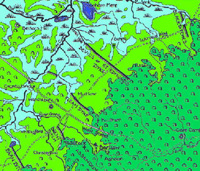
Defensive dykes on Icknield Way |
|
c.575
|
The Devil's Dyke at Newmarket, and the Fleam Dyke, a few miles further to its south west have long been believed by some historians to date from around this time to defend from attack from the west. Recent detailed work has confirmed that these earthworks date from the 5th to the 7th centuries. They are also aligned to face an attack from the south west.
The Devils Dyke is the largest of these works, at over seven miles in length. Today they look like old railway embankments, and the work needed in their construction must have been similar. The Victorians needed a thousand men to build one mile of embankment in a year, and this scale of effort would have been needed by the Anglo Saxons for seven years in the construction of Devils Dyke. Only a great king of a prosperous nation could undertake such a feat of engineering.
Previously, some had claimed that, on the contrary, they were thrown up earlier by the British to stem the Saxon advances. In practice they may have been used, reused, and modified by successive generations. There are other earthworks within the area of the East Anglian kingdom, such as Black Ditches on Cavenham Heath and Risby in Suffolk, and the War Banks at Lawshall. These may have more obscure origins.
|
|
576
|
By about 575 AD the Anglo-Saxons in England began to understand the use of coins as money. The continental gold solidus and tremissis had long been known in England, but for decades had mostly been used as jewellery. These gold coins were of high value, and thus not for use in everyday transactions, but they could be given as part of large land transaction or marriage settlement. Merovingian coins from Frankia were not unusual in England at this time.
|
|
c.577
|
Bath, Cirencester and Gloucester were taken by the Saxons and the West Welsh became isolated.
|
|
578
|
Roger of Wendover, writing in about 1235, recorded that Tyttla now ruled over East Anglia, presumably following the demise of Wuffa. Bede, in about the 720's, also noted Tyttla as the father of Raedwald and Enni. Wuffa himself may have been one of the very first to be buried under a mound at the newly founded aristocratic grave site now known as Sutton Hoo.
|
|
580
|
In 580 or a short time before, King Aethelberht of Kent married Bercta, or Bertha, the daughter of the Frankish King, Charibert of Paris. This gave Aethelberht a degree of power and prestige over those Franks who had settled in Southern England. He would grow to dominate the whole of the south following this dynastic alliance.
In return, Aethelberht agreed that Bercta could continue to worship in her Christian faith. Most of the kingdoms just across the Channel from England were Christian, and the English kings would have been well aware of that religion, even if they kept their own traditional beliefs.
As ties grew with the continent it is not surprising that late in the 6th century Merovingian Frankish gold coins reached our shores and a purse of such coins was found at Sutton Hoo. No Anglo-Saxon native coinage existed at this time.
|
|
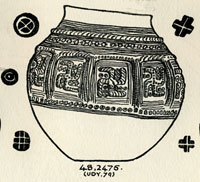
Lackford Cremation Urn & potmarks
|
|
585
|
In 1947 T C Lethbridge excavated a pagan Saxon cemetery at Mill Heath, Lackford. The site is above the 50 foot contour on a peninsula of land between the south bank of the River Lark and the Cavenham Mill stream. He found between 400 and 500 cremation urns, a concentration which is unusual for the Lark Valley, where earth burials, or inhumations, are more prevalent. There were swastikas present upon a number of cremation urns, and the Anglo-Saxon cemetery at Lackford has yielded some of the most exquisite designs of this image.
|
|
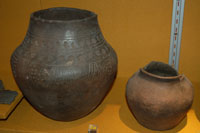
Lackford funerary urns
|
|
blank |
These urns were also important because they confirmed in some cases the identification of individual potters. Lethbridge called some of the pottery the Icklingham type, as he assumed that Anglo-Saxon potters had used the same local clay as had the Romano-British potters who had left kilns at Icklingham and on West Stow Heath. For some years the Icklingham potter has also been identified as the Illington/Lackford potter. He has been known to have working during the late-sixth century somewhere along the west Norfolk/west Suffolk borders. His output was cinerary urns of a number of standard types decorated in two or three routine styles. Decoration was stamped on to the vessels while they were still damp. One of these stamps has been found and it was made out of a red-deer antler and bore a cross die. Stamps frequently used by the potter, or potters, were a cross-in-circle, a St Andrew’s cross and a concentric circle with a blob centre. Decoration in the main was restricted to pots used as cinerary urns. Distribution of the products was roughly within a radius of some thirty miles centred on Lackford with one outlying example some eighteen miles further on at Castle Acre in Norfolk.
|
|
590
|
In Rome, Gregory had been Prefect since 583, and in 590 he became Pope. In the 570s he was said to have seen English slaves for sale in Rome, and determined to convert the English to Christianity. He decided to contact Bercta, the Frankish Christian wife of Aethelberht of Kent, to seek assistance to send a mission to the English. He resolved to send Augustine, the Prior of Gregory's new monastery of St Andrew, in Rome, to lead the mission. After a few false starts, Augustine would reach England by 597.
Also in about 590 the first Anglo-Saxon coin was struck in Canterbury, making it the earliest to be minted in England since Roman times.
|
|
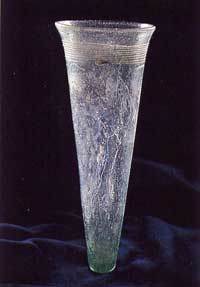
Glass beaker-Westgarth Gardens
|
|
blank |
By this time the settlements like West Stow were long established. Nearby at Lackford a large cemetery of several hundred cremations in globular urns has been excavated. West Stow had its own burial cemetery. It has been thought that by now the custom of cremating human remains and burying the ashes in a funeral urn may have been replaced by burial of the body. Lethbridge believed that this was not so, and that cremation continued until the Christian era after about 650.
Many more cemeteries have been found than settlements, simply because human remains and grave goods have been more easily identified than the soil marks remaining from decayed dwellings. Thus we know of cemeteries in Bury at Northumberland Avenue, Barons Road and Westgarth Gardens, but do not know where their settlements lay.
|
|
597
|
Columba of Iona died in this year, but Christianity now had another advocate in the south.
Augustine finally arrived in Kent on his mission from the Pope. He was met by King Aethelberht on the Isle of Thanet, where Aethelbert had given them permission to land. This seems to have resulted from Athelbert of Kent being married to Bercta, or Bertha, his Frankish princess from Northern Gaul, who was a Christian. She was asked by Pope Gregory to use her influence on the King and paved the way for Augustine.
At first Aethelbert confined the Christians to Thanet, and when he did meet them, he travelled to the Island himself, rather than summoning them to his own halls. He spoke to them out of doors, a position which Bede said was to avoid the possibility of witchcraft.
Aethelbert, at first, refused to accept the Christian message, but he permitted them to preach throughout Kent, and soon allowed them to set up home in Canterbury, where the King himself lived with his Christian wife, Bercta.
Augustine and his entourage began to build and restore the remnants of Roman churches, and began to convert the population of Kent to the Roman form of Christianity. He brought 40 monks with him and at Christmas 597 some 10,000 people were baptised in Kent. Canterbury would become the home of English Christianity from this beginning.
Athelbert was rising to become High King of England and political refugees seem to have been accepted at his court, including Raedwald, later to be King of East Anglia. Raedwald possibly converted to Christianity in Kent at this time. Politics at this time was sometimes a violent power struggle and those on the losing side often fled to other kingdoms. In this respect the Anglo-Saxons were much like the Romans.
|
|
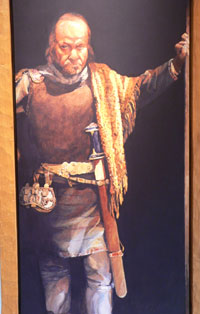
How Raedwald may have looked |
|
599
|
With Christianity rapidly being adopted in Kent, and Aethelbert of Kent rising in power beyond his Kentish borders, Tyttla of East Anglia died.
The mighty Raedwald returned to East Anglia and took over his Wuffing inheritance as their king and seems to have ruled over all East Anglia. Bede recorded that Raedwald ruled East Anglia from Rendlesham in East Suffolk.
He now married a royal bride, whose name we do not know, but she had been married to an East Saxon prince, and already had a son of royal blood, called Sigeberht.
The royal cemetery was nearby at Sutton Hoo but was unrecorded until its first excavation in 1939. Raedwald's first act may have been to oversee a lavish burial of Tyttla at Sutton Hoo.
|
|
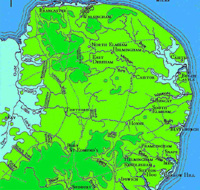
Wuffing kingdom of East Anglia |
|
600
|
By this time, the East Anglian kingdom of the Wuffinga dynasty was independent, powerful and economically successful. But the threat from Mercia in the west was increasing. Gipeswic, or Ipswich, was probably set up as a trading post around 600, and would quickly develop through the century, becoming a major port and industrial centre. Raedwald may have been involved in establishing Ipswich.
The 7th century had three great characteristics, not seen before in Anglo-Saxon England. These were:
- (a) the consolidation of the countryside into Kingdoms, ruled by a king of a 'royal' family;
- (b) the introduction and spread of Christianity, which had died out after the Romans had left; and
- (c) the rise of towns again for the first time since the Roman withdrawal.
These changes, which took place over the 100 years of the 7th century, changed Anglo-Saxon England beyond recognition. The economy changed with the development of trade and the introduction of urban life. Christianity brought new patterns of thought, literacy and the facility to keep records and write down history. The King and his court exercised more and more authority over everybody's lives.
As time passed the system of government became more formalised. The way in which the king received his "feorm" or food rent was, no doubt, refined by local moots or councils. The military service owed to the local lord and to the king was also refined, so that each district had to find a specified number of fighting men for the "fyrd", or military levy. These duties would require areas to be grouped together in some formal manner, which would later evolve into the "Hundreds", which survived as units of local government into modern times.
|
|
601
|
By 601 King Aethelbert of Kent had accepted Christianity as his personal religion, along with many of his Kent subjects. In 601 Pope Gregory wrote to him to "hasten to instil the knowledge of one God, father, Son and Holy Spirit, into the kings and nations subject to you."
The Pope is clearly acknowledging Aethelbert's position of High King over much of Britain, as well as encouraging him to recruit them to Christianity.
|
|
603
|
Aethelfrith of Northumbria defeated Aeden, King of the Scots. He was gaining power in the north, while Aethelbert was growing in power in the south.
The Welsh bishops rejected Augustine's teachings, preferring to retain their own Irish form of Christianity.
|
|
604
|
According to Bede, it was in the year 604 that King Raedwald of East Anglia converted to Christianity.
By at least 601 King Aethelbert himself had converted to Christianity and he wanted his allies to join him. Both Saeberht of the East Saxons and Raedwald cemented their relationship with the Bretwalda Aethelbert, by travelling to Kent to be baptised and to take Holy Communion. St Augustine himself may have baptised Raedwald in Canterbury. Augustine also consecrated Mellitus as the first Bishop of London, with his seat at St Paul's, to minister to the East Saxons. It seems likely that Augustine would have wanted to appoint a Bishop into Raedwald's East Anglian realm as well. Perhaps Raedwald was not ready to accept such a posting at this time.
Raedwald was to become notable because he would set up a pagan altar and a Christian altar within one temple at his home, and seems to have trodden his own fine line between the old religion and the new. After all, Pope Gregory himself had advised Augustine not to destroy existing pagan temples, but to convert them to Christian worship. Bede recorded that it was Raedwald's new pagan wife who led him astray from Christianity. Probably it would have been politically necessary for a new king of a pagan people to pay some regard to their existing beliefs and sensibilities.
In any case, Raedwald's Christianity was the first to be established north of the Thames, and despite his temple of two altars, Christianity would become the established religion for the future.
|
|
605
|
Raedwald of East Anglia and his new wife had two sons together, named Raegenhere and Eorpwald. Raedwald's wife had another son, called Sigeberht, by her first husband. Sigerberht seems to have spent much of his life in Gaul once Raedwald had his own heir, where he was safe from Raedwald.
At about this time King Aethelbert of Kent produced the first written Code of English Law. Basically it was a list of the amounts of compensation payable for various crimes. These amounts were by no means equal justice for all. Aethelbert defined the classes of society, and each class got a different level of compensation. The classes presumably reflected the social realities of the time, and were divided as follows:
- The King
- Earls
- Freemen
- Churls
- Bondsmen
- Slaves
The church had ensured its place in this code. If anyone stole the property of God and the Church the compensation was to be twelvefold. Stealing from a Bishop brought elevenfold compensation, a priest ninefold, and so on down to a cleric who got threefold compensation.
There were about 90 crimes described between different classes of person, and how much each was to be paid for.
St Augustine would have advised the king on these laws, but he was to die in 605. The second Archbishop of Canterbury was Laurence, who had accompanied Augustine from Rome.
|
|
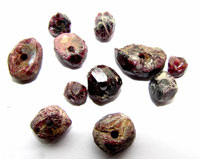
Rough cut garnet beads |
|
615
|
Although we may picture the early Anglo-Saxon period as a time when subsistence farmers led an isolated and bleak existence, there are many archaeological finds which led us to believe that early life was not without its pleasures and delights. Neither was early England cut off from the rest of the world. Objects from distant lands tell us that trade routes reached into the Far East, such as these garnet beads which were very likely originally from Sri-Lanka. These rough cut beads may have been intended for further cutting and processing, but have instead been used as unfinished beads, perhaps because they were of a lesser quality than required for the best work. These beads came from the Aldeborough area and were sold on E-Bay in 2012.
|
|
616
|
The High King of the South was acknowledged to be King Aethelbert of Kent. However, on 24th February in 616, he died after a reign of 56 years, according to the Anglo Saxon Chronicle. He was succeeded by his son Eadbald, but Eadbald was not a baptised Christian. In itself this need not have prevented a conversion, but he decided to adopt the old custom of marrying the wife of the old king. As she was also his stepmother, the Christian church viewed this as incest under a ruling by Pope Gregory, and the marriage must have horrified Archbishop Laurence of Canterbury as much as it re-assured the still pagan rural population. The mission to Kent must have been very shaky at this point.
Around the same time the old Christian King Saebert of the East saxons also died. He is a strong contender for the royal person who was buried in a rich and elaborate grave chamber at Prittlewell in Essex. Now located in the suburbs of Southend, this was a strategic port on the River Thames.
King Saebert of Essex had three pagan sons who now demanded to take communion as their father had done. Bishop Mellitus of London had to refuse as they were not baptised, and the result of a seemingly minor disagreement was that Mellitus and his Christian mission was "out a-shoved" from Essex. In this case it would be several decades before Christianity returned to the East Saxons. Mellitus had to go to Canterbury.
Aethelfrith of Northumbria had recently defeated the King of Scotland. In 616 he also defeated the Welsh at Chester, isolating Wales. Bede saw this as a punishment from God, because the Welsh would not adopt Roman ideas about religious practices, including the date of Easter. However, the increasing power of Aethelfrith now threatened the other kings of the south, particularly Raedwald. As Christianity had still not reached Aethelfrith, it meant that his rise must have also threatened the future of that religion in England.
By the end of the year it must have seemed that Christianity was in full retreat in England. Only King Raedwald with his two altars was still ruling as a Christian King. Archbishop Laurence, Bishop Mellitus and Bishop Justus of Rochester now decided to abandon their mission to Britain, according to Bede. Apparently they did not leave, and Bede also recorded that it was the example of Raedwald that eventually would bring King Eadbald, and his kingdom of Kent back into the Christian fold.
|
|
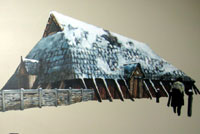
Possible Hall at Rendlesham |
|
617
|
Since about 590 King Aethelfrith of Northumbria had been expanding his realm. He had conquered the Scots and the Welsh from his stronghold at Bamburgh Rock. By marrying the Princess Acha of Deira, he had extended his reach southwards into modern Yorkshire. He had driven out Acha's brother Eadwine, first into Mercia, then into East Anglia.
Eadwine or Edwin was thus a claimant to the throne of Northumbria, and to escape reprisals had finally sought safe shelter at the court of Raedwald. He was welcomed as an honoured guest in Raedwald's Hall at Rendlesham. The Hall at Rendlesham has never been found, but this illustration from Sutton Hoo Centre suggests how it might have appeared. Although Aedwine was far away from Northumbria, Aethelfrith could not accept Aedwine on the scene, however far off.
Aethelfrith therefore tried to bribe Raedwald with two offers of great wealth to kill Edwin to remove him as a rival. Raedwald refused to kill Edwin, and Aethelfrith then offered even more, together with the threat of war if his wishes were again refused. Bede tells this story together with tales of mysterious visitors who come at night to make offers to help Aedwine to escape, and to give him advice. This may all be linked to the view that while he had been in East Anglia, Edwin was converted to Christianity by Paulinus, who was a part of Augustine's mission to Canterbury. Part of the arrangements made to support Aedwine might have included the condition that he had to convert to Christianity.
Bede claimed that Raedwald had finally decided to betray Aedwine, but was persuaded by his Queen that no amount of gold would counterbalance the dishonour such a betrayal would mean. War with Northumbria was now inevitable, not only because of Aedwine, but because of the power struggle between two great kings for overall mastery of the country.
Raedwald did not wait for Aethelfrith to carry out his threat of war. Instead, he went on the offensive and led his army north as far as the River Idle, south east of Doncaster, on the southern edge of Aethelfrith's kingdom.
Raedwald's army was in three columns, and the Northumbrians managed to destroy one column, killing Raedwald's son in the process. The other columns, led by Raedwald, stood firm against Aethelfrith and finally defeated his army after killing him.
The Anglo Saxon Chronicle recorded this event many years later as follows:
.
"Here Aethelfrith, king of the Northumbrians, was killed by Raedwald, king of the East Anglians, and was succeeded by Eadwine."
This battle gave Raedwald enormous new power in the country, although his son, Raegenhere was killed in the process. Edwin was given Northumbria as a client king of Raedwald. As the old King of Kent, Ethelbert, had died the year before, Raedwald was now acknowledged as the English Bretwalda. This meant he was the High King, with his power extending even into Northumbria. No previous English King had been so powerful, and the message would have been clear, that Christianity included success in battle.
|
|
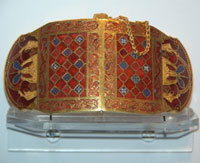
Sutton Hoo epaulette |
|
618
|
Raedwald was a Wuffing, and part of the Wuffing prestige was to link their family origins to Odin and to Caesar. This claimed link to a Roman Emperor may help to explain some of the objects found in the royal grave at Sutton Hoo. These shoulder clasps were directly reminiscent of the epaulettes worn by Roman Officers, and the show of wealth and power which they embodied would strengthen Raedwald's claim to overlordship of Britain.
Following the battle on the River Idle and Raedwald becoming acknowledged as Bretwalda, it is likely that this victory would have inspired other kingdoms to adopt or re-adopt the new Christian religion. At some point the new King of Kent, Eadbald decided to accept baptism, and Canterbury became re-established as a Christian centre. Its future had been in grave doubt after the christian King Aethelbert of Kent died early in 616 to be replaced by his pagan son Eadbald. In addition, Saebert of the East Saxons had also died in 616, and Bishop Mellitus had been sent packing from London.
|
|
622
|
Meanwhile, far away at the eastern end of the old Roman Empire, the Prophet Mohammed escaped from Mecca, and began to impart his message around Persia, which had temporarily conquered Constantinople, Jerusalem and Egypt under the Zoroastrian King Chosroes II.
|
|
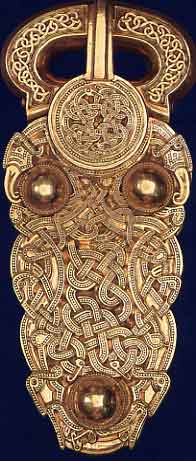
Sutton Hoo gold buckle |
|
625
|
Around 624 or 625, Raedwald, the High King of the East Angles, must have died, although we have no written evidence for this. After the battle on the River Idle, Bede gives Raedwald no further space. Raedwald was the greatest of the Wuffinga kings, and it is generally accepted that he was buried in a pagan ship burial at Sutton Hoo, in great splendour.
However, this is not the whole story. Raedwald knew about Christianity, had been baptised and had adopted it, although his burial was basically in the traditional pagan manner of the Wuffings. He was known to have kept a temple with two altars, one for the old gods and one for the new, an arrangement which scandalised Bede. Bede blamed Raedwald's wife for this arrangement as she was thought to always retain her pagan beliefs.
We can accept that Raedwald never actually rejected Christianity, as he was buried with some Christian icons. By his head were two baptismal spoons, engraved Saulos and Paulos, often given to those who had accepted an adult conversion. Cruciform designs are visible on several objects in the grave, including silver bowls. Despite Bede's misgivings from his monastery in Jarrow in a century later, Raedwald probably considered himself a Christian King, and was probably regarded as such by those around him at the time.
The royal treasure of Raedwald was excavated by Basil Brown and the British Museum in 1939 at Sutton Hoo, near Woodbridge. The undisturbed grave goods were buried in a huge clinker-built ship some eighty feet long with provision for forty oarsmen. The ship and its contents were buried under a large mound of earth in a royal cemetery containing at least eighteen other mounds of various sizes. The astonishing treasure of 'royal regalia', weaponry, and objects of everyday use gives an important insight into Anglo-Saxon life at the beginning of the 7th Century. If it had not been for Sutton Hoo we would not be able to realise the incredible wealth, power, influence and connections of 7th Century kings in England. These burials parallel the 6th and 7th century boat-graves at Vendel and Valsgarde in Sweden. Possibly the Wuffings were kin to the Royal House of Upsala, the Scylfings.
|
|
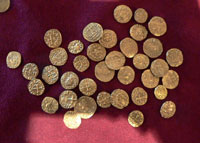
The Raedwald Coins |
|
blank |
One of his grave goods was a purse containing Frankish gold coins, each one minted in a different place on the continent. For some time this has been interpreted as a gift from a continental king, but Dr Mark Blackburn is sure that such coins had been circulating in England for several decades. Therefore they could just as easily have been collected in this country.
|
|
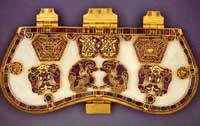
The purse lid |
|
blank |
The purse lid illustrates the use of what we now call cloisonne work, where garnets appear to be sunk into a gold background. The garnets must have originated from the far east, with Sri Lanka as the most likely source. The buckle is said to be of Frankish origin, but some of the work is likely to have come from royal workshops at Rendlesham. Some pieces include the use of blue glass, which probably came from Kent, where the Roman Britons had learned its manufacture and use.
Clearly there were strong connections with Kent and the rest of 'England' and beyond that the European kingdoms from Gaul to Scandinavia. Political and economic commerce was sophisticated and highly developed by this time, with complex diplomatic activity connecting East Anglia to a much wider area.
Although the Wuffings stronghold was in south-east Suffolk, they probably had royal outposts or vills at places like Exning, Coney Weston and Bedericsworth in West Suffolk. Raedwald had also presided over a great trading outpost arising at Ipswich. For two centuries London and York had been the only major east coast trading ports. The presence of the Wuffings on the River Deben caused Sutton to be a busy port, but the higher reaches of the Orwell at Gipeswic were to become far more important. Gipeswic is today known as Ipswich and was to remain a busy port until the 20th century.
|
|
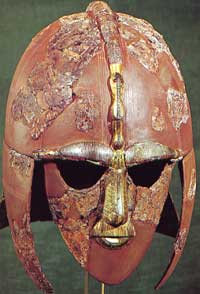
Helmet from Sutton Hoo
|
|
blank |
The great ceremonial war helmet shown here was placed in the grave by the head of the king. This helmet can be seen as a symbol of power and leadership, and has been interpreted as the anglo-saxon equivalent of a royal crown.
The king's pattern welded steel sword had a bejewelled scabbard with large buttons ornamented by a gold and garnet representation of a cross which must have been intended as Christian symbolism.
From the humble villages like West Stow, to the great wealth of the rulers, it is obvious that Anglo-Saxon society was highly stratified. In such a society there were obligations of protection, loyalty and service. The Wuffings drew their strength from the hundreds of little villages, like West Stow, which formed the backbone of their kingdom.
In turn, the people needed a strong king, for without the law and order that he could impose, they could not raise their crops and their families in safety.
|
|
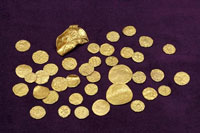
West Norfolk hoard find 2021
|
|
blank |
For many years the Deben estuary and Rendlesham were seen as the only known seats of power at this time in East Anglia, based upon the Sutton Hoo finds. A coin hoard newly found in 2021 in West Norfolk must now question these assumptions.
The largest hoard of Anglo-Saxon gold coins to be found in England was declared treasure at an inquest held in Norwich in early November, 2021.
Four gold objects were discovered with 131 coins in a field in west Norfolk, most by an anonymous metal detectorist who notified the appropriate authorities.
Gareth Williams, curator of early medieval coins at the British Museum, said the "hugely important find", which dates to the same era as the Sutton Hoo ship burial near Woodbridge in Suffolk, is "the largest coin hoard of the period known to date".
The first coin was discovered in 1991, but it was not until 2014 that further coins, dating to about AD 610, were found.
Some were minted in the Byzantine empire, but most were from the Merovingian kingdom, which broadly corresponds to modern day France. Most of the coins are Frankish tremisses, and there are also nine gold solidi, a larger coin from the Byzantine empire worth three tremisses.
This includes coins struck from the same die in the same workshop as those found in a purse at Sutton Hoo. (The Sutton Hoo burial included a purse of 37 gold coins, three blank gold discs of the same size as the coins and two small gold ingots, as well as many other gold items.)
A stamped gold pendant, a gold bar and two other pieces of gold were found at the same time, suggesting the hoard should be seen as bullion, valued by weight rather than face value.
Tim Pestell, senior curator of archaeology at Norwich Castle Museum and Art Gallery, said: “This internationally significant find reflects the wealth and continental connections enjoyed by the early Kingdom of East Anglia.
“Study of the hoard and its findspot has the potential to unlock our understanding of early trade and exchange systems and the importance of west Norfolk to East Anglia’s ruling kings in the seventh century.”
|
|
626
|
Around 625 we believe that Raedwald was succeeded by King Earpwald, one of Raedwald's sons, but Earpwold could not inherit his father's position as high king, or Bretwalda, over the other English kings. It seems that Edwin of Northumbria was now accepted as Bretwalda, or High King of England. Edwin or Aedwine had actually been placed on the throne of Northumbria by Raedwald after the battle on the River Idle in 616.
Aedwine had allowed Paulinus to set up a church in York, and to spread Christianity in Northumbria. Paulinus had gone to York with Aethelburh, the Christian sister of Eadbald of Kent, when she married Aedwine in 625. However, Aedwine was not yet ready to accept baptism and make the new religion an official part of his own rulership.
Ipswich was now coming into some prominence on its present site and was notable for the distinctive Ipswich-ware pottery thought to have been produced here from c.620 to c.850, after which Thetford-ware came to dominate. (However, the start date of 620 has now been called into question, and suggested that Ipswich Ware did not come into production until 50 years later. At present this must be taken as a consideration.)
Penda became King of Mercia and ruled until 655. Penda was a committed pagan and would use his opposition to Christianity to forge alliances against the new Christian kingdoms. As the power of Penda would grow, historians consider that East Anglia would decline in power.
|
|
627
|
King Aedwine of Northumbria finally decided to accept Christian baptism, and destroy the pagan temples in his kingdom. On 12th April 627 he was baptised at York by Paulinus, along with many of his nobles, family and friends. Bede was very impressed by Aedwine's kingship and Christian values, whereas he had regarded Raedwald as ignoble because of his twin altars. Raedwald had apparently failed to make his own sons into Christians, so now it was Edwin who was said to have persuaded Earpwald of East Anglia to convert to Christianity. Earpwald would have seen this as part of his alliance with the Bretwalda.
Although Raedwald had been a baptised Christian, he does not seem to have tried to convert others to his faith, an attribute which Bede gives to Aedwine, and the new religion now gained further strength in East Anglia. However, it seems that there were still powerful adherents to the old ways who had mortal objections to a Christian rule in East Anglia.
Our main source for the period, Bede’s Ecclesiastical History, tells us that the reign of Rædwald’s son Eorpwald ended in assassination and backsliding. He says in Book II, chapter 15:
"Not long after Eorpwald's acceptance of Christianity, he was killed by a pagan named Ricbert, and for three years the province relapsed into heathendom."
This little known pagan king called Ricbert may well have been another of Raedwald's sons,or one of the sons which his wife had produced from an earlier marriage. If so, he was brother or half brother to Sigeberht. It is considered that Ricbert ruled East Anglia from 627 to 629. As he took over by murdering Earpwald, and had rejected Christianity, this may have led Sigeberht, to consider claiming the throne himself and proclaiming Christian principles in the kingdom. Sigeberht seems to have been a stepson of Raedwald's, and son of Raedwald's queen, deriving his royal claim from this fact.
|
|
629
|
By 629 some unknown events transpired that allowed Sigeberht to take power, and he ruled East Anglia until about 636. According to Bede, Sigeberht had been in exile in Gaul, and there had been baptised into the Christian faith. Until this time the English kings do not seem to have accepted baptism until after they became kings. Sigeberht was the first man to already be a Christian before taking up power.
We do not know Ricbert's fate, as Bede merely says that Sigeberht succeeded to the kingship. However, it is implied in later events that Sigeberht had a military background, and so it is not unlikely that he gained power by force.
Another man called Aethelric was also recorded as King at this time, and he may have shared the kingdom with Sigeberht by a division of territories. Bede appears to refer to Aethelric as Ecgric. He was the son of Eni, who was the brother of Raedwald, and so had some claim to the kingdom. If Sigeberht was only a stepson of Raedwald, and Aethelric his nephew, this might explain why a power sharing arrangement was agreed.
|
|
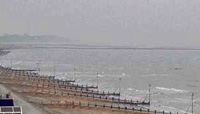
Walton castle below the waves |
|
631
|
Bede wrote that Sigeberht "laboured to bring about the conversion of his whole realm", and brought or encouraged Bishop Felix to provide a Christian education in East Anglia.
Bede devoted a chapter in Book III, chapter 18 of his history to the life and death of the devout King Sigeberht. Note that in this version of the succession, Bede ignores Ricbert, who, according to Book II, chapter 15, had succeeded Earpwold, ruling for three years before Sigeberht. "After the death of Earpwald, successor of Raedwald, the kingdom of the East Angles was ruled by his brother Sigbert, a good and religious man who had been baptized long previously in Gaul while he had been living in exile to escape the hostility of Raedwald. When he returned home and became king he wanted to copy Gaul and founded a school for the education of boys in the study of letters. In this project he was assisted by Bishop Felix, who had come to him from Kent and provided him with teachers and masters according to the practice of Canterbury."
An infrastructure to support Christianity was thus introduced into the countryside of Saxon East Anglia when Bishop Felix established his see at a place called Dommoc. Along with Christianity came literacy, a skill the pagan early Anglo-Saxons had not thought of value to them, and so had ignored. St Felix was from Burgundy and his Christianity was of the Roman tradition. He remained the first Bishop of the East Angles until his death in 647. The location of Dommoc is a cause for discussion. It was once thought most likely that it was located at Dunwich, and most writers give this as a certainty. Perhaps this was because of the similarity of names, and because of the importance of Dunwich by the 15th century. However it now seems unlikely that Dunwich really existed as a centre at this time, and Dr Sam Newton argues that "Dommoc" was established at Walton Castle. Old Saxon shore forts like Walton, left behind by the Romans, seem to have been attractive to the first Christian foundations at this time. Unfortunately, Walton castle, and any trace of Felix's chapel, fell below the sea by modern times.
In 631, Anna, a brother of Aethelric, and son of Eni, must have been living in Exning. His father, Eni, was Raedwald's brother, so Anna was a nephew of Raedwald. This area, on the edge of the Fens, would have been rich in marshland products as well as located on the strategically vital Icknield Way. The Icknield Way was the only real land based route into East Anglia from Mercia. Anna was to become known as the Father of Saints, and in 631 his wife gave birth to Aethelthryth, who would grow up to became the founder of a Convent at Ely.
Anglo-Saxon gold thrysmas were minted at this time, at first copying Frankish or Roman coins.
|
|
632
|
In 632 the Christian King Aedwine of Northumbria, also acknowledged as Bretwalda, or High King, was killed by Cadwallon. Cadwallon was a pagan ally of Penda, king of Mercia, and this news must have galvanised the inhabitants of East Anglia.
"Here Eorpwald was baptised," according to the Chronicles. He was king of the East Anglians, and all versions of the Chronicles give this date. However, the Chronicles make no mention of Sigeberht, and according to the chronology adopted here, following Steven Plunkett, Eorpwald had died in 627. This shows how contradictory and confusing the dating of this period can be.
|
|
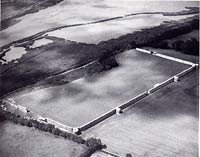 Burgh Castle
Burgh Castle |
|
633
|
During Sigeberhts' reign a holy man came to his halls from Ireland called Fursa or Fursey. He brought with him his brothers Foillan and Ultan, as well as a number of other priests. It may be that Sigbert and Felix were looking for someone to run the school they had founded. The monastery and school was at Cnobheresburh, either at Burgh Castle near Yarmouth, or maybe at Caister on Sea. St Fursey or Fursa later migrated to the continent, but the monastery survived in the charge of his brother. Fursey represented the Irish celtic Christian tradition and some of his ideas would have differed from those of Felix.
Early Saxon churches were also set up within the walls of three other Saxon shore forts left behind by the Romans, Bradwell, Reculver and Richborough. This supports the idea that Fursey was located at Burgh Castle, one of the earliest such Roman forts. After the episode of Fursey, the castle seems to have remained a deserted ruin until Norman times. Felix had already established his see at Dommoc, also now believed to have been sited at another old Saxon Shore fort, Walton Castle.
|
|
635
|
In his later years Sigeberht was reported by Bede, to have handed over all his authority in East Anglia to King Egric, probably the man known to other historians as Aethelric. Aethelric had already been ruling over part of the territory of East Anglia in a joint arrangement with Sigeberht.
Sigeberht himself thus appears to have been the first English king to abdicate. His reason was in order to become a monk.
Around 635, Sigeberht had founded a monastery at Bedericsworth, today called Bury St Edmunds. Bede states that he built the monastery for his own use. It was one of the earliest schools of English literacy, but it was not the type of structure whose ruins we see today, but was probably made of wood. The site may have been very close to the later abbey site at Bury. Bede recorded that Sigeberht now retired to live in his monastery. A marginal note made in the 12th century book, the Liber Eliensis, is the only evidence we have which identifies its location as Bury. He entrusted his earthly kingdom to his kinsman, Egric, (or Aethelric), who had already governed part of the kingdom , and "devoted his energies to winning an everlasting Kingdom".
Both Ipswich ware and Thetford ware have been excavated from the site of the Bury monastery, indicating an occupation here between the 7th and 9th centuries.
Why would Sigeberht have chosen this location at Bedericesworth? Did the Wuffing royal family perhaps own, or have rights over, land in the area? Did a relative already live on the site? Or was it a site of wilderness and marsh, peopled with demons and spirits, sorely in need of a holy presence?
The site was bounded by the River Linnet to the South, the River Lark to the east and the marshes of Tay Fen to the north. In reality it was probably surrounded by marshy pools and waterways, and quite isolated. As far as we know the Romans had failed to be attracted to Bury, and by this time there were a few anglo-saxon villages occupying the river banks in the area nowadays covered by the town. It was a good place to seek isolation, far from the royal court at Rendlesham, but safely inside the Wuffing kingdom.
With an abdicated king in residence, this would have been the start of the settlement as a villa regia or royal town. Over the years it was possibly able to acquire such rights as holding a market, but more importantly, charging market tolls.
Eventually the rivers may well have been used to transport some goods to and from the small market. The first market place was believed to be located around the area of today's St Mary's Square, being the junction of a North-South Road (Northgate Street and Southgate Street) with modern Westgate Street. The North-South road was in effect the High Street and probably ran in a straight line through the modern Abbey Gardens before the growth of the Abbey caused its diversion around the abbey walls.
Around the same time as Sigeberht's new foundation, Bishop Aidan founded a monastery on Lindisfarne. He was an Irish monk from Iona.
|
|
636
|
"And Bishop Felix preached the faith of Christ to the East Anglians", said the Anglo-Saxon Chronicle. Felix would certainly have been spreading the word at this time, although according to the chronology adopted in this chronicle, the mission of Felix would have begun in East Anglia in 631.
|
|
640
|
Penda of Mercia had a vision to establish Mercia as the most powerful state in the land. Mercia was landlocked, with no obvious physical boundaries. This meant that the kingdom was surrounded by potential hostile alliances. To counteract this threat, Penda had pursued a policy of establishing warlike supremacy over any other territory that he could. In 628 he had defeated the West Saxons. In 633 he had attacked and killed Edwin of Northumbria at Hatfield. The exact date when Penda attacked East Anglia is unknown to us, but D P Kirby has established that it must have been in about 640.
The location of Penda's attack upon East Anglia is also unknown, but it is likely that he attacked up the Icknield Way, exactly where the Fleam Dyke and Devil's Dyke were built for protection. King Aethelric was now in charge of all East Anglia and would have mustered an army in defence at the Dykes. His brother Anna, living at Exning, would be expected to play a major part in defending this area. It seems likely that the Mercians made a first attack which was held back, probably at the Fleam Dyke. The defenders would then fall back to the stronger position at the Mickle Dyke, the Great Ditch running seven miles from Reach to Newmarket, now known as Devil's Dyke. Aethelric believed that he needed Sigeberht's help to stand with him and help rally his forces. Perhaps a deputation rode to Bedericsworth to persuade Sigeberht to help. The round trip from Devil's Dyke to Bury to fetch him could be done easily in a day on horseback.
Thus, according to Bede, Sigeberht did not die peacefully in his monastery at Bury, but was killed in battle.
"The Mercians led by King Penda attacked the East Angles who, finding themselves less experienced in warfare than their enemies, asked Sigbert to go into battle with them and foster the morale of the fighting men. When he refused, they dragged him out of the monastery regardless of his protests and took him into battle ... in the hope that their men would be less likely to panic ... under ... a gallant and distinguished commander. ... Mindful of his monastic vows, Sigbert ... refused to carry anything more than a stick ... both he and King Egric were killed and the army scattered. These kings were succeeded by Anna, son of Eni."
Despite Penda's military victory, he was still subject to the authority and power of Oswald of Northumbria. Penda's intention was to not to keep hold of conquered territory, but to show that he was the stronger man, and that the defeated King should accept him as a superior. An annual tribute would also be payable. Because of this the East Angles were able to retain rule by their own Wuffing clan in return for acknowledging Penda as overlord.
We believe that King Anna (or Onna), son of Eni, ruled East Anglia from 640 to 654. He was a nephew of Raedwald, and brother to Egric/Aethelric.
East Anglia had enjoyed close ties with Kent for many years. In 640 King Eadbald of Kent died, and was buried at Canterbury.
King Anna of East Anglia had a daughter called Seaxburh. In 640 she was married to the newly elevated King Eorconbold of Kent, whose father King Eadbald had just died. This cemented an alliance between Kent and East Anglia, greatly strengthening both parties. Such an alliance was doubly necessary because of the growing power of the pagan King Penda of Mercia.
Seaxburh would become the mother of two future Kings of Kent, but in later life she would enter a monastic life, eventually becoming the second abbess at Ely.
King Anna had been living at Windmill Hill, Exning with his family, guarding the Icknield Way approach from Mercia. Hitherto, all Wuffing power had been centred around Rendlesham in East Suffolk. Even if Anna made his main centre at Rendlesham after becoming King, he would very likely have retained a strong family presence in this western area.
|
|
642
|
King Penda of Mercia had finally gathered the strength to attack King Oswald of Northumbria. Oswald was killed and his body mutilated. Oswald would be remembered as St Oswald in later years.
|
|
644
|
King Penda of Mercia now turned against Wessex, and drove out its new King Cenwalh. Cenwalh had to take refuge in King Anna's Wuffing halls in East Anglia. Penda was becoming ever more of a danger to any Christian kingdom. Cenwalh himself was not yet baptised, despite hosting Canterbury's missionaries in his kingdom. In East Anglia he was persuaded to convert by King Anna. Anna had long practised Christianity and all his children were raised as Christian, and some would even become sanctified in later years.
In Rochester, Paulinus died in 644. He was one of the Christian missionaries who had first arrived in Canterbury, and by now had links all over England. He had known Raedwald and preached in East Anglia before moving north.
In 644 Fursa decided to leave his monastery at Cnobersburgh. He went off to join his brother Ultan as a hermit. He handed over the monastery to Foillan, along with the priests Goban and Dicuill, and whatever other inmates had joined them. Later he moved to Gaul, where he founded the abbey at Lagny and two other churches.
|
|
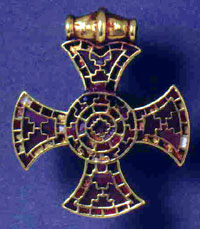
The Ixworth Cross |
|
645
|
Christianity now existed in many parts of East Anglia, even if it had not reached all of the common people. King Anna had been living at Exning for many years before he became King, and he and his family were Christians. So even the western parts of Suffolk were familiar with the Christian religion from its earliest introduction to the land of the Eastern Angles. This very high status garnet and gold cross pendant was found in a grave at Stanton, not far from Ixworth in Suffolk, in 1856. It indicates that the local nobility were possibly part of the royal family. They were well established as Christian, as well as extremely wealthy.
|
|
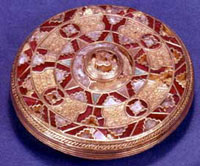
The Ixworth Brooch |
|
blank |
Also found in the Ixworth Cross grave was an elaborate brooch of gold, inlaid with jewels, reinforcing the view that some wealthy and high status family lived in the area. The gold and garnet formations of these items reflects some of the jewellry work found at Sutton Hoo. This shows that the workshops of the kings at Rendlesham were still operating at this time.
Both the Ixworth Cross and the Brooch are now in the Ashmolean Museum in Oxford.
|
|
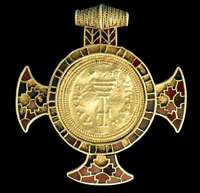
The Wilton Cross |
|
blank |
A similar cross to the Ixworth example was found at Wilton, near Brandon. It has the same cruciform shape, but the central boss is replaced by a Roman coin of Heraclius, which included an image of the cross. This object is now in the British Museum, where it is described as
"a cross-shaped gold and garnet cloisonné pendant set with an Early Byzantine coin.
This pendant displays the reverse of a lightweight solidus of the Byzantine Emperor Heraclius (reigned AD 610-41), which can be dated to between 613 and 630. The coin reverse, with a cross with bars across the ends of the arms, on a stepped base, has been mounted upside down, perhaps so that it appeared the correct way up to the wearer.
The creation of cryptic motifs within a larger cloisonné pattern was a favourite device of Germanic jewellers from the fifth to the seventh centuries.
The cross can also be dated by comparison with other high-quality Anglo-Saxon jewellery with overall garnet cloisonné. The combination of cell-shapes is paralleled on the Sutton Hoo ornaments and on a cloisonné cross found at Ixworth in Suffolk. These exceptionally fine pieces of jewellery were probably made in an East Anglian workshop active in the early seventh century AD. "
Another high status object, a large gold buckle from a similar period, was found at Tostock, just east of Bury St Edmunds. Steven Plunkett has pointed out that these sites can all be associated together with the valley of the River Blackbourne.
|
|
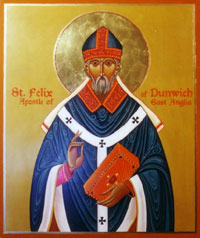
St Felix |
|
647
|
Bishop Felix of the See of Dommoc in East Anglia, died in 647. He had spent 17 years spreading the Gospel in East Anglia, and fostered two strong Christian Kings in Sigeberht and Anna. Churches were probably founded at Ipswich, Sudbury, Exning, Blythburgh and Cambridge during this period, as well as Sigeberht's foundation at Bury St Edmunds.
Felix was buried at Dommoc, but long afterwards his remains were translated to Soham and then to Ramsey Abbey.
Bishop Felix passed away on 8 March 647 and was at once honoured as the Apostle of East Anglia and a Saint. He is still remembered in local churches today, as shown by this modern icon of him, which was a Commission for the Orthodox Church of St John the Wonderworker in Felixstowe.
Felix was replaced by Thomas as second Bishop of Dommoc, a man previously a deacon in the Fens, perhaps at Soham.
Now that the exiled King Cenwalh of Wessex was a baptised Christian, King Anna of East Anglia helped him to regain his royal seat in Wessex. Cenwalh had been a refugee in Anna's halls for three years since he was driven out of Wessex by Penda.
Two of King Anna's daughters travelled to Faremoutiers in France to enter the nunnery there. They were called Aethelburh and Saethryth. Although East Anglia had its own monastic foundations, these were for men, and Bishop Felix himself had been from Burgundy, so there were probably close connections between the royal family and French monasticism.
|
|
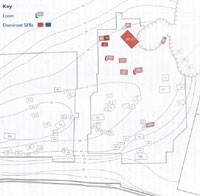
West Stow by 650 AD |
|
650
|
It used to be thought that the period of occupation on the West Stow site lasted for about 200 years from 450 to 650. This plan shows how Stanley West thought the village would have looked by 650 AD. The village had shifted its focus over its life away from the river to the north-east corner of the higher ground.
After this time, over a period of perhaps 25 years, the village was thought to have moved about a mile to the east perhaps around a new church. West Stow today is therefore centred on this new site. The original site was gradually deserted. There is evidence that other pagan Saxon settlements in Suffolk were abandoned at around this time, possibly to make a clean start on a new Christian site.
However, new research about a type of pottery called Ipswich ware, found at West Stow, now casts doubt on this dating. Paul Blinkhorn now suggests that Ipswich ware did not begin to be made until 720. As such pottery was found at West Stow, it indicates that the village may have continued in occupation into the 8th century. Stanley West discussed this issue in "West Stow Revisited", (2001), but found several problems with it.
The title of "Middle Saxon Period" is assigned to the period from c.650 to c.850, when Christianity was being adopted by the formerly pagan Saxons. Other names for this time are Early Medieval or Christian-Saxon.
During the Middle Saxon period the Fens and the clay soils were settled once again so that by the 9th Century most of our villages had been founded. However, we need to remember that the sites of named villages may have moved over time since then.
At Brandon, the Staunch Meadow site was first occupied in the mid to late 7th century. Unlike many Anglo-Saxon settlements, Staunch Meadow showed no signs of any previous occupations in the Iron Age or earlier. The site was almost an island, set in the riverside wetlands there. This settlement would develop into a monastic establishment of high status over the next 200 years.
Fursey, the Irish missionary who had founded Cnobhersburgh monastery in Suffolk, died in about 650. According to Bede, Fursey died in France on a journey to revisit Suffolk. His body was buried at Peronne and found to be incorrupt four years later, showing "how great a man Fursey was". This shows that the idea that a saint's body would not decay after death would be well established by the time that St Edmund's sanctity was being established, many years later.
|
|
651
|
Aethelthryth was one of the daughters of King Anna of East Anglia. In 651 she was married to Tondberht, a noble son of the southern fenland peoples. Ely was an island in a sea of marshy lakes and fens at this time. This marriage brought Ely into the East Anglian sphere of influence. Aethelthryth had been brought up at Exning, and probably knew Tondberht and his family already. Soham was a Christian foundation located between the two places. According to the story of St Aethelthryth, she remained a vigin throughout this short marriage.
In about 651, Penda, the King of Mercia, attacked the monastery at Cnobhersburh, probably from the sea. King Anna's East Anglian force arrived to rescue church books and treasures, but too late to prevent its destruction. The East Angles were defeated. Abbot Foillan and some of the monks fled to France with the Monastery books. The result of this attack was a disaster for the monastery, but a greater one for the kingdom, as King Anna himself was exiled. It is possible that King Anna fled to the Welsh border, where he founded a small church in the area of Much Wenlock.
The Irish left Burgh Castle after these events and Irish influence declined in East Anglia. The monastery appears to have been destroyed. Cnobhersburg is believed to be the Old English name for Burgh Castle.
|
|
652
|
Bishop Thomas of Dommoc died in about 652. Archbishop Honorius replaced him by Berhtgysil, giving him the name Boniface.
|
|
653
|
By 653 King Anna was back in the Kingdom of East Anglia, possibly living in a royal dwelling at Blythburgh, with his son Jurmin or Eormin. East of Blyford is an open area called Bulcamp. Having survived one defeat fighting against Penda, Anna was quickly to lose another battle against the Mercians.
|
|
654
|
The Mercian king Penda had killed King Sigebert of East Anglia in about 640, and continued to dominate Britain during the reigns of the next two kings of East Anglia. The first was King Anna, who had succeeded to the throne when both Sigeberht and Aethelric were killed.
Now, in 654, King Anna of East Anglia also met his death at the hands of the Mercians in the battle of Bulcamp, near Blyford in Suffolk. His son Jurmin was also killed along with many of their men. It was the last battle to be fought on East Anglian soil for many years. King Anna and his son were buried at Blythburgh according to the Liber Eliensis. According to Bede,
"Anna was killed by the same pagan King of the Mercians who had slain his predecessors", i.e., Penda. The Mercians are now thought to have continued to have dominated East Anglia, although the East Angles kept their own kings until around 865 when the Danes arrived.
Aethelhere now inherited the kingdom of East Anglia. He was the brother of the slain King Anna, and another son of Eni. He realised that he could not continue to hold out against Penda and his Mercian army, and decided to join him instead.
|
|
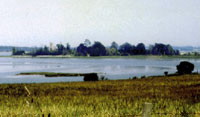
St Botolph's at Iken |
|
blank |
"654: Here King Anna was killed and Botwulf began to build a minster at Icanho". This reference in the Anglo Saxon Chronicles, versions A and E, is generally accepted to refer to Botolph building a religious site at Iken, located on the River Alde in East Suffolk. The site was probably on an island promontery, reached by a causeway which was cut off at high tide. Botolph was to become immensely influential in East Anglian Christianity, and his influence was seen in the later foundations at Wearmouth and Jarrow in Northumbria.
The site at Iken was only about an hour's walk from Rendlesham, where the Wuffings had their royal base. Botolph must have had close ties with the royal family to be allowed to do this, and its establishment may well have been as a memorial to Anna.
|
|
655
|
Penda of Mercia had now succeeded in securing East Anglia as an ally, and decided to attack Northumbria in his quest to rule the whole country, and, at least in Bede's eyes, to restore paganism. The joint armies of Mercia, Gwynedd and East Anglia now attacked King Oswy, and his smaller force, at Leeds. Somehow Oswy broke out to establish a position by the River Winwaed.
Bede tells us how the Christian faith of Oswy and his meagre force allowed them to defeat, and put to the sword, the much larger pagan forces, their kings, and at least 30 of their top generals. Those who survived the battle were trapped in the flooded river and drowned.
Thus did King Aethelhere of East Anglia die at the Battle of Winwæd in 654 or 655, fighting as an ally of King Penda of Mercia, who also died there. Bede saw Aethelhere as a villain who had been Christian but fought for the pagan Penda. Some commentators have even interpreted Bede as saying that Aethelhere was the instigator of the war, but Dr Sam Newton believes that this interpretation is simply the result of a scribe omitting a full stop in his copy. Aethelhere himself may have thought to preserve his own homeland by throwing in his lot with the superior force of Penda.
They were defeated in this battle by the Christian King Oswy of Northumbria, and so, according to Bede, this led to Mercia becoming Christian.
King Aethelhere was now succeeded by his brother Aethelwald, who ruled East Anglia from 655 until 664. Aethelwald was the fourth son of Eni, who had been a brother of the great King Raedwald. He was by now the last surviving nephew of King Raedwald.
Bede clearly saw the kingdoms of the East Angles and the East Saxons as separate. He recorded an East Saxon King Sigbert the Small, who was succeeded after some time by a second King Sigbert neither of whom appear to be the same man as the King Sigeberht of the East Angles. The second Essex Sigbert was a friend of King Oswy and used to visit him in Northumbria. Oswy persuaded this Sigbert to convert to Christianity and sent Cedd to evangelise the East Saxons in Essex. This Sigbert "was succeeded by Swidhelm." Swidhelm or Suithhelm became King of the East Saxons in about 655.
|
|
656
|
At some point in his rule, King Aethelwald of East Anglia stood as Godfather to King Swithhelm of the East Saxons. Bede recorded that:
"Swithhelm ...was baptised by Cedd himself in East Angles Kingdom in the kingly town that is named Rendlesham, and he was received at the baptismal bath as godson by Aethelwold, East Angles King...."
This statement contains the information that the Wuffing kings were based at Rendlesham at this time, and that they were Christian. The Godfather-Godson relationship might also imply that Aethelwold was a senior king to Swithhelm.
Clearly Aethelwald must have invited Swithhelm and Cedd, and no doubt many other friendly nobles, to Rendlesham for the baptism. Cedd probably visited Botolph at nearby Iken at the same time.
|
|
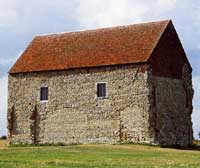
Saxon Church at Bradwell
|
|
660
|
Cedd, Bishop of the East Saxons, had probably seen Botolph's foundation at Iken. He went on to found his own monasteries at Tilbury and Bradwell on Sea. A stone church survives at Bradwell, dedicated to St Peter, and its form may tell us something about other foundations at the same period. In particular it may show us how Iken may have looked in Botolph's time. Cedd built his foundation in the remains of the old Roman fort of Othona, just as other old Roman forts had been re-used by the Roman Christian missionaries to England.
The princess Aethelthryth, one of the daughters of King Anna, had been married to Tondberht in 651. He had died soon after, and in 660 she was married to Ecgfrith, the 15 year old son of King Oswy of Northumbria. She was about 30 at this time, but once again, the legend tells us that she remained a virgin. This marriage gave East Anglia an alliance with Northumbria.
|
|
661
|
The great monastery at Peterborough was founded in about 661 by Wulfhere, brother of King Peada of Mercia. At this time Peterborough was called Medeshamstede. This established the area as firmly within Mercian power.
|
|
663
|
The Synod of Whitby was called to settle differences in the teachings of Irish and Roman Christianity, such as the date of Easter. It took place at the monastery there, ruled over by Hild. It seemed to be Iona and its Irish satellites against Western Europe and Southern Ireland. However, the Irish cause was argued by Coleman, Bishop of Lindisfarne, Hild of Whitby and Cedd. The Synod concluded in favour of the Roman tradition, and Coleman left England, returning to Iona.
|
|
664
|
By 664 a plague was spreading across England, and was probably a major problem from 663 until 667. Archbishop Deusdedit died in Canterbury, as did King Erconberht of Kent. Cedd and most of his monks died at Lastingham, in Yorkshire.
In 664 King Aethelwald of East Anglia also died. He was the last of the four nephews of King Raedwald, who had ruled the kingdom for 35 years.
King Aethelwald of East Anglia was now succeeded by the obscure, but long - lived King Aeldwulf, who ruled until 713. Aeldwulf was the son of Aethelric, who had died in battle alongside Sighbert, fighting against Penda in 640. Aethelric was known to Bede as King Egric, and was Sighbert's brother. Little has been recorded of King Aeldwulf, but he ruled for 49 years, and succeeded in having a peaceful realm throughout that time. Christian institutions would become widely established throughout these years.
The first east anglian sceattas were probably minted in the reign of Aeldwulf.
In the Middle East, the Arabs took Syracuse. They had taken Damascus in 634 and Jerusalem in 637.
|
|
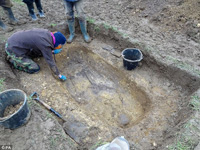
Excavating Winfarthing woman
|
|
665
|
Buried some time around 650 until 675, the discovery of Winfarthing woman, with her rich grave goods shows that power and wealth at this time was not confined to coastal East Anglia.
Newspapers reported on 4th December 2017 that a significant Anglo-Saxon find had been made at Winfarthing, near Diss, in Norfolk. The papers were actually reporting upon the publication of the annual report of the Portable Antiquities Scheme for 2016. The discovery of an “exquisite” gold pendant by a student metal detectorist is being credited with rewriting the understanding of Anglo-Saxon history.
Thomas Lucking is in line for a £145,000 pay-out after unearthing an aristocratic burial site in a part of Norfolk overlooked by generations of archaeologists because of its heavy clay soil.
The find of the female skeleton wearing a pendant of gold imported from Sri Lanka and coins bearing the marks of a continental king is prompting a fundamental reassessment of the seats of power in Anglo Saxon England.
|
|

Winfarthing woman's garnet pendant
|
|
blank |
Much of the gold jewellery was still on the skeleton of the woman, who would have been of extremely high status, buried between around 650 and 675 AD, and probably one of the earliest Anglo-Saxon converts to Christianity.
One of the large pendants, found lower down on the skeleton's chest, was made of gold and inlaid with hundreds of tiny garnets and in itself is valued at £140,000.
A gold cross among the treasure counts as one of the earliest “potent” symbols of Christianity ever found.
The Norwich Castle Museum is now raising the £145,000 needed to buy the trove, dubbed the Winfarthing Woman, whose craftsmanship is the “equal” of the famous Staffordshire Hoard, according to Senior Curator Dr Tim Pestell.
“It shows that the person buried in this grave was of the very highest status, certainly aristocratic and quite possibly royal.”
Mr Lucking found the site in 2015, aged 23, and now works as a full-time archeologist.
"We could hear this large signal. We knew there was something large but couldn't predict it would be like that," he said of the discovery. When it came out the atmosphere changed."
The Winfarthing Woman was highlighted in the annual report of the Portable Antiquities Scheme (PAS) as an example of best practice by amateur metal detectorists.
|
|
667
|
Plague seems to have spread all over Europe, contributing to Rome's inability to appoint a new Archbishop of Canterbury until 669. At least one candidate died of plague in Rome, where he had been sent to be consecrated.
Botolph of Iken was said to have been bitten by a snake around 667, which required him to take a long rest from his work. Adders are still frequent on the sandy heathlands along the Suffolk coast, such as Snape Common. He seems to have travelled around Suffolk on convalescence, very possibly reaching Botesdale, which takes its name from him. He is said to have founded two churches during this excursion, one to St Peter and one to St Paul. By 669 he was back at Iken.
|
|
669
|
In about 669 Bishop Wilfred of Ripon sent a young priest called Coelfrith to study with Botolph at Iken. Botolph had a profound influence on Coelfrith who would found the famous monastery at Jarrow in about 681.
The year 669 was also significant to English Christianity because it was the year that Pope Vitalian sent Theodore to be the new Archbishop at Canterbury. This post had been vacant for five years since the death of Deusdedit in 664. Archbishop Theodore and his assistant Hadrian would set about the reform of the English church, and re-establish Canterbury as the seat of a great centre of learning and scholarship. The rise of Canterbury inevitably eclipsed provincial centres of learning like Iken.
Theodore appointed Bisi to be the Bishop of the see of Dommoc, in East Anglia, as Bishop Berhtgisl, had recently died.
|
|
671
|
"Here there was the great mortality of birds". This comment from the Anglo-Saxon Chronicle must be one of the earliest written English observations on natural history, but the Anglo-Saxons would have been intimately familiar with the natural world.
|
|
672
|
One of King Anna's daughters was called Aethelthryth or Etheldreda and she became later known to us as St Audrey. As a young princess of the Wuffing dynasty, she had loved gold and jewelled necklaces, but had been brought up in a Christian family. She was brought up at Exning and was first married to Tonberht of a noble Fenland family. Tonberht had died after a short period. There followed an extraordinary marriage to Egfrith of Northumbria, and a refusal to give up her chastity. In 672, her husband, now King Egfrith of Northumbria, despairing of an heir, finally released her to follow a religious life.
She was placed in a monastery at Coldingham, near Berwick, to take the veil. There were other nuns here, as they were later criticised for gossiping and weaving fancy fabrics. Aethelthryth seems to have felt that she was still within her husband's power, and planned an escape back to her own estates at Ely.
|
|
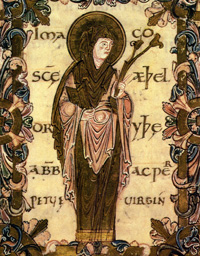
St Etheldreda of Ely
|
|
673
|
Aethelthryth, the wife of King Ecgfrith of Northumbria, had determined to live a monastic life, and had been in a monastery near Berwick for about a year. In 673 she fled from Northumbria, pursued by soldiers, to return to her own estate at Ely.
She founded a double monastery at Ely, one part of which has been claimed to be the first nunnery in the country. Later she was to become known as one of the most famous saints of Anglo-Saxon England. Bede recorded that because of her life of purity and chastity, her body remained free of decay after death, which occurred in 679.
Aethelthryth was born in Exning, a daughter of Anna, one of Raedwald's nephews. Anna became King Anna of East Anglia in 640, ruling until killed by Penda of Mercia in 654. Anna's children feature high in the annals of East Anglian saints.
Aethelthryth would be succeeded as Abbess of Ely by her sister, Seaxburh or Saxburga. Another daughter of Anna was Ethelburga who became Abbess of Faremoutier, in France. The final daughter of King Anna was Withburga, and she was also pious, founding a religious house on the fen edge, probably at West Dereham.
Religious foundations would continue at Ely in the following centuries. St Audrey would become associated with East Suffolk when a large area of land surrounding Woodbridge was given to the Abbey at Ely by King Edgar in 970. Her growing importance is shown by the illustration here, which was included in the Benedictional of St Aethelwold, produced in the period from 970-980 AD.
In 673 Archbishop Theodore held the first Church Council at Hertford to discuss the new canon laws for the English church. These governed the Bishops and Kings alike. One new rule was that no man could have a second wife while the first still lived. This would prevent King Ecgrith of Northumbria, for example, from taking a new wife now that Aethelthryth was in a nunnery, thus denying him any heirs. In 677 Ecgrith would evict his local Bishop, renounce the faith, and re-marry in the traditional form, some two years before Aethelthryth's death.
Bishop Bisi of Dommoc attended the Council, but Theodore saw that he was in poor health, and believed that he was no longer up to the job of running the new church in East Anglia. After the Council had ended, Theodore appointed two Bishops to take over Bisi's work. They were called Aecci and Baduwine. Aecci was asigned to Dommoc, but a more northerly site within East Anglia was to be found for Baduwine in order that the word could be spread more widely.
|
|
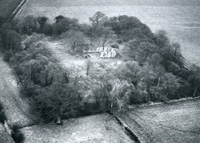
South Elmham minster
|
|
674
|
In about 673 or 674, during the reign of King Aeldwulf of East Anglia, a second Christian see was established in East Anglia at South Elmham to partner Dommoc. Bishop Baduwine was assigned to this new see, partly to take the strain off Bisi at Dommoc, but also to increase the church coverage on the ground. As Bisi was ill, another Bishop, called Aecci was standing in for him. Christianity seems to have become fairly well established again in East anglia after this. If Dommoc was located at Wolton castle, it was down at the south east corner of the kingdom. Another more central endowment would strengthen the spread of the religion.
There is an ancient ruin at South Elmham, pictured here, within an enclosure. The enclosure is called Minster Yard, and covers an area of 4 acres. The ruin is 101 feet long. However, these ruins appear to be dated to the eleventh century, and are probably not the site of the original foundation. However, Norman Scarfe and others still believe that the foundation was at South Elmham, albeit on another location nearby. Scarfe has suggested that the land parcel made up of the Elmham villages and the Ilketshall villages around Bungay, were the endowment for the South Elmham Minster.
There is another claim to be the site of the Elmham Minster at North Elmham in Norfolk. There may have been two sites for the new see, spaced conveniently to cover most of Norfolk and Suffolk, or North Elmham may have been created later under Danish rule.
|
|
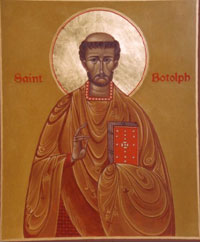
St Botolph |
|
blank |
This was in the same year that St Botolph died at his minster at Iken. He was buried there, but in later years his revered remains would be moved or "translated", as Iken declined in importance and other centres grew more prominent.
He was revered as a saint almost immediately, and his fame spread all over England and altogether sixty-four ancient churches were dedicated to him. Although the majority of these were in eastern England, there are dedications to him in all parts of England, perhaps in remembrance of his travels. Notably all four Gates of the City of London would have chapels inside them dedicated to St Botolph. His fame even spread abroad, especially to Holland, northern Germany and Denmark.
He became revered for his prophecies, exorcisms, miracles and charitable works, and in later years Saint Botolph became a patron saint of travellers. St Botolph is still revered in some local churches, as shown by this modern icon, which was a Commission for the Orthodox Church of St John the Wonderworker, Felixstowe.
Botolph was succeeded as Abbot at Iken by Aethelheah.
In Northumbria in 674 a new monastery was founded at Wearmouth. One of its founders was Coelfrith, who had visited Botolph at Iken in 669, and been very impressed by both Botolph and his monastic rule. Coelfrith would later found Jarrow monastery in 681.
|
|
675
|
Gold coins were largely replaced by silver coins in the last quarter of this century. The silver coins are called sceattas. Gold was of too high a value to be of much use in commercial transactions at the time, and had been gradually degraded in the coinage until it was very pale. Subsequent coinage was virtually entirely silver until 1257. All coins were produced by hammering a piece of metal between two engraved dies until the 16th century.
At Gipeswic or Ipswich, a pottery quarter was becoming established on the north east side around Carr Street and Cox Lane. These were thrown on a wheel and kiln fired. The skill may have been brought in from Frisia by a group of migrants. The pots are known as Ipswich Ware, and were produced for the next two centuries.
The quay at Ipswich was well developed, with a number of jetties running out into the water. It was a major trading port by now, and many trades supported it like ship builders and repairers, blacksmiths, leather workers, antler workers and basket makers. St Peter's church was being built at the time, and a market place would have been needed to supply the tradespeople with food. Looms produced textiles, and there may well have been a trade in slaves.
|
|
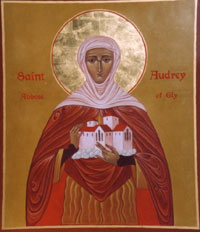
St Audrey |
|
679
|
Plague once again broke out in the country, and persisted until 680. It soon claimed a noble and holy victim.
St Botolph having died in 674, another East Anglian saint, St Aethelthryth or Audrey, died in 679. She died at her foundation in Ely of a plague tumour on her throat. She had asked to be buried in a plain wooden coffin alongside the other nuns in the cemetery there.
Audrey was born in 630 on the royal estate of the East Anglian Kings at Exning in West Suffolk, and was the daughter of Anna, the future King of East Anglia. Her Old English name was 'Aethelthryth', meaning 'noble strength', which later came to take the form 'Etheldred' or 'Etheldreda' and then 'Audrey'. Baptised by the Apostle of East Anglia, St Felix, it was he who also instructed her in the Faith.
In 673 Audrey set up a monastery for both monks and nuns at Ely, and became its Abbess. Some time after about 696, St Audrey was venerated as a saint and became the greatest woman-saint of East Anglia. Her shrine in Ely attracted pilgrims from far and wide. Today she is probably more widely known than her male contemporaries. This modern icon was a commission for St John's Orthodox Church in Felixstowe.
She was succeeded as abbess of Ely by her sister, Seaxburh, who came from the nunnery at Sheppey.
Seaxburh was another Wuffing princess, and also daughter of King Anna of East Anglia. She had been married to Erconberht, King of Kent until 664, and her son Ecgberht had been King of Kent from 664 to 673, and was succeeded by her second son, Hlothere in 673. Seaxburh had founded her own minster at Sheppey, and was living there by 673. As we have seen, in 679 she removed herself to Ely, to take up her sister's work closer to her childhood home at Exning.
In 679 Archbishop Theodore of Canterbury called the Second Council of Hertford to dicuss church matters. The Pope had decreed that England required twelve bishops. In addition it was decided to hold the council twice a year in future, at a place called Clofeshoe. The location of Clofeshoe is unknown to us. Claude Morley suggested in the early 20th century that it was located at Mildenhall in Suffolk, but nobody else has accepted his view.
|
|
680
|
By now there were two bishoprics or sees in East Anglia. One was well established, and was located at a place called Dommoc, and one was newly established at South Elmham, called Helmham in old English.
Monastic foundations were also believed to have been established at Clare and Sudbury in our area.
Most settlements built a church after this time, but were probably mainly of timber. Stone was not widely used until well into the 11th Century.
|
|
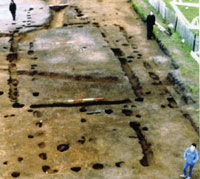
Timber Church at Brandon |
|
blank |
There is a middle Saxon site that has been excavated at Brandon, between the Little Ouse on one side and a marsh on the other, called Staunch Meadow. This seems to have become a literate and devout Christian settlement with a church. This was of timber and could have been a Monastery. Although its beginnings may have been around this time, it would develop over the next 200 years. It is also likely that a church was first founded in Haverhill around this time. It was located where Clements Lane crosses Camps Road into Crowland Road at Burton End. Local tradition knew it as St Botolphs, but recently it has become thought it was more likely to have been dedicated to St Mary.
Ipswich also began its explosive growth from this time and seems to have been important industrially and commercially long before the emergence of Thetford, Dunwich or Norwich. Ipswich ware pottery was sold widely over eastern England. This pottery was the first industrially produced ware since Roman times. Ipswich ware was so superior to the hand made pots elsewhere that it was sold all over East Anglia, and has been found in Kent, and as far north as County Durham.
Royal vills of the Middle Saxon period were residences of peripatetic kings and were a trading network for the products of Ipswich. One such vill was at Bury St Edmunds, under the name of Bedericsworth.
|
|

The Trumpington Cross
|
|
blank |
One of the most unusual Christian burials known in Britain has been found near Cambridge near Junction 11 of the M11 during 2012. The body of an Anglo-Saxon teenage girl had been interred on a wooden bed, wearing a striking gold cross set with garnets.
The cross, valuable enough to suggest that the girl, 16, was of high status, is only the fifth of its kind to be found, and was excavated from her grave in Trumpington, Cambridgeshire. She was in one of four graves, the others being more typical examples of Anglo-Saxon burials of the time, with no indications of Christianity. Set with garnets, the cross dates the grave to between 650AD and 680AD.
“We think there’s only been one other bed burial combined with a Christian pectoral cross ever found,” said Alison Dickens, of Cambridge University’s archaeological unit. “Bed burials are conspicuously rare, but there is a little cluster around the Cambridge area.”
The cross, 3.5cm (1.5in) in diameter, is only the fifth such piece to be found in the UK. The most famous came from the coffin of St Cuthbert (died 687) in Durham Cathedral. It is very similar to the Ixworth Cross and the Wilton Cross, both found in the 19th century.
A cemetery at Westfield, Ely, dug by the Cambridge unit in 2006, also contained a later 7th-century burial with a cross pendant, of a child aged 10-12, probably a girl, who was thought to have been associated with the first monastery at Ely, founded in 673.
|
|
681
|
The monk Coelfrith moved from Wearmouth Monastery to found a new monastery at Jarrow. He took 22 monks with him, and at least one young novice. Coelfrith had visited Botolph at Iken in about 669, and had been very impressed by the East Anglian Abbot and his monastery.
In the year 680, at the age of 7, a young boy had been sent to the monastery at Wearmouth to be educated, and he was one of the company now moved to set up the new foundation at Jarrow. He spent the rest of his life following the monastic rule at Jarrow and he was later to become known as the Venerable Bede.
|
|
685
|
Cuthbert, a hermit from Farne, was made Bishop of Lindisfarne. He died two years later, and eleven years after that, Bede recorded that his body remained whole and incorrupt.
|
|
690
|
Coins known to modern collectors as Series C of Primary Scettas are also known as the East Anglian Runic series.
|
|
696
|
St Aethelthryth had died in 673, and been buried in the churchyard at Ely with her nuns, at her own request. In 696 her sister, Seaxburh, now the Abbess at Ely, decided to move her remains into the church at Ely. She sent a group of people into the deserted town of Cambridge to find a suitable coffin. They returned with a white marble sarcophagus. Upon digging up the body of the saint it was discovered to be incorrupt, and the tumour on her neck had healed by miraculous means.
Long before the time of St Edmund it was becoming an accepted feature of religious life that a saint's body would not decay after death.
|
|
699
|
A prince of the Mercian royal blood called Guthlac decided to give up his career as a military man and become a monk. He built a hermitage dedicated to St Bartholomew in a desolate island in the Fens which became Crowland Abbey. A small community from Mercia established themselves here with Guthlac, and the Mercian Bishop Haedda, consecrated the site.
|
|
700
|
There was civil war in Northumbria and Pict and Scots wars to the North. Into the 8th Century, in parallel with the consolidation of the secular powers of kings and their kingdoms, the Christian church established its own institutions and hierarchies based on a network of monasteries and abbeys. These became centres of learning and scholarship and particularly of literacy, but their aim was always to study Christianity and spread its message. Much of the doings of kings and states and the way people lived were of only passing interest to the church. Little is known of what occurred in East Anglia in the eighth century, and in the last half century is usually described as being dominated by Mercia, although retaining its own kings.
|
|
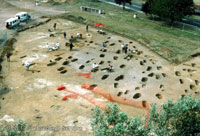
Excavated graves at Eriswell 104 |
|
705
|
Some time around 700 the two centuries old settlement by the Caudle Head Mere in Eriswell was abandoned. Excavations which began in 1997 at RAF Lakenheath revealed a hitherto unknown Anglo-Saxon cemetery of fifth to seventh century date. This photograph was taken when many of the graves had been excavated in this first phase. By the end of the project approximately 90% of the cemetery had been uncovered and a total of 261 graves investigated. This cemetery was designated ERL 104, but excavations in 1999 preceding a pipeline insertion, found a further cemetery known as ERL 046. Another dig in 2001 exposed a site designated ERL 114, which was adjacent to Lady Briscoe's excavation of ERL 008 in 1958/59.
By 2013, a total of around 450 burials had been excavated at this site, which today is known as Peace Keeper Park by the USAF, who occupy the area at RAF Lakenheath. As well as the cemeteries, there was evidence of local occupation back at least to the Bronze Age.
Caudle Head Mere is the site of a natural spring, feeding a stream which drains into the Fens. It is below Maids Cross Hill, and is just behind Lakenheath village which itself stand on the edge of Fenland. Before the airfield was constructed from 1940 onwards, this was an area of sand dunes, scattered with flint artefacts from the stone ages, including the mesolithic. Nearby, just to the south, Lords Walk was along the 15 foot contour, just above swampy ground, used as a droveway, back at least to the Iron Age, for taking cattle to the summer pastures on the Fens.
Evidence was found of a crouched Bronze Age burial, in a mound, which had attracted around itself one of the Anglo-Saxon cemeteries. Roman remains show that the area was occupied during the Roman period, ending in the 5th century.
The Anglo-Saxon nobleman in the first horse burial discovered here might have been born here around 470, possibly representing a founder generation of Anglo-Saxons in this area. Some 16 Sunken Featured buildings were found, representing the earliest "Saxon" occupation here. Jo Caruth, the archaeologist who excavated this area, has suggested that the cemeteries were located so as to be a "gateway " to the settlement.
By 700 AD it is also suggested that the water levels at the mere and its surroundings had risen, making further occupation uncomfortable, and the whole settlement was possibly relocated eastwards to Eriswell village itself.
By 2013 it is clear that this Eriswell Early Anglo-Saxon site, containing evidence of both life and death, is of international significance.
|
|
710
|
The Arabs invaded Spain bringing the religion of Islam or Muslim faith.
|
|
713
|
Following the death of King Ealdwulf, his son, King Aelfwald ruled East Anglia until 749 and was to be the last of the Wuffing dynasty. Aelfwald was a scholar, whcih in these times meant that he had learned to read and write and studied Christianity. He seems to have promoted Christianity and probably tried to emulate the developments in Northumbria. Certainly his kingdom had a tradition of literacy going back to Sigbert at Bedericsworth and Botolph at Iken. East Anglia seems to have had stronger Scandinavian affinities then any other early English kingdom, its most outstanding feature being the rite of royal ship funeral. In such a society the heroic epic poem Beowulf might have had its origins, perhaps to link the Wuffings with the Wulfings of Beowulf, an ancient and royal house back in the old country. Beowulf's action seems to take place in pagan Scandinavia from about 450-550, but its narrator is from a Christian society. The monster Grendel is like the creatures thought to live in fens and marshes. A grindle is a ditch or drain and the name survives in Grindle Gardens, Bury and at Wattisfield and Stanton.
Aelfwald continued to mint the coinage of the time, known to us as sceattas. These coins did not contain the king's name.
|
|
714
|
At Crowland, Guthlac died in 714. Crowland in the Fens was within Mercian control, which was itself now ruled by Coelred. Coelred had been ruler of Mercia since 709, and he controlled London, the East saxons, the Middle Angles of Mercia and Lindsey. Thus he surrounded East Anglia. However, he preferred to plunder monasteries within Mercia to finance a life of riotous living. Crowland was protected from Coelred to some extent by the goodwill of Aelfwald, who so regarded the memory of Guthlac that he commissioned a monk named Felix to write "The Life of Guthlac".
|
|
716
|
Around 716 Aethelbald became ruler of Mercia, following the death of Coelred. Aethelbald had been sheltering from Coelred at Crowland, and he now endowed a new church at Crowland to replace Guthlac's humble wooden hermitage.
By this time the Northumbrian church reached a standard of culture achieved by few others at its time. It had libraries of books from Italy and France, continental panel paintings and stone built churches, with a flourishing stained glass workshop at Jarrow. Jarrow is believed to have had 200 monks and Wearmouth had some 400 living in. At this time the kingdom of Northumbria included most of modern Yorkshire. It was literally "North of the Humber".
Bede wrote that Egbert finally converted the monks of Iona to the Catholic Easter and the canonical tonsure.
|
|
725
|
During the 720s, Cuthwine was bishop of Dommoc. He made a journey to Rome and returned with illustrated books including a Life and Labours of Saint Paul. Bishop Cuthwine was known to Bede, who wrote that he had seen this book of Cuthwine's. Cuthwine probably also brought back copies of the Epigrammata of Prosper Tiro and the Carmen Pachale of Sedulius.
Thus, although we are not certain where Dommoc was, we know that it had a library with some magnificent books.
|
|
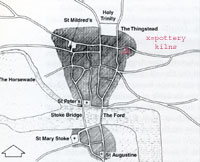 Middle Saxon Ipswich
Middle Saxon Ipswich |
|
730
|
Excavation by Keith Wade for the Suffolk County Archaeology Service has revealed that the central part of the town of Ipswich was laid out during the reign of Ælfwald. As the trade capital of his kingdom this was presumably done with his support, or under his direction. A rectangular grid of streets linked the earlier quayside town northwards to an ancient trackway running east and west along the valley contour. This new grid of streets was divided into rectangular plots. The new town of the 8th century was built over the graveyards of the 7th century.
Pottery was becoming a large trade industry for Ipswich around Spring Road, and the making of combs from antlers was also important, judging from the finds of many archaeological digs.
|
|
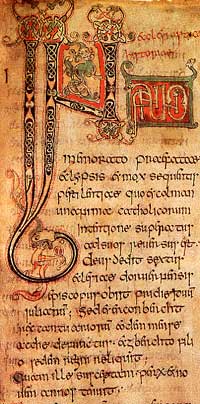 Bede's History
Bede's History |
|
731
|
By 731 when he was nearly 60, Bede had completed his Ecclesiastical History of the English People. It was in Latin, the language which could be read and understood throughout Europe, and was a church history of Anglo-Saxon England recording its saints and the miracles associated with their lives and, after death, their tombs. It was not intended to be a history of the state or the economics or society of the time. However, much of what we know of Anglo-Saxon history was recorded in this book. The project was inspired by Abbot Albinus of Canterbury who ruled there from 709 to 732 and who supplied information about Kent and arranged for research in papal archives at Rome for documents concerning England to be copied for Bede.
An otherwise unknown Abbot called Esi reported on East Anglian matters. In 731 Bede named Aldberct as bishop of Dommoc, and Hathulac as bishop of Helmham. By this time presumably Bishop Cuthwine of Dommoc had died, to be replaced by Aldberct or Aldberht.
Pre-Christian Anglo-Saxon society had virtually no documents and no books. The King's word and oral tradition regulated society. After Christianity came in 630, written records were still very few, and what little there was, were mostly to do with the administration of the church such as letters from the Pope, church lists, etc.. However, around 538, the British cleric Gildas had written his version of the Saxon invasion, and Bede seems to have relied on this for the early part of his book. Gildas was living at that time in an area of Britain outside of Saxon control. Bede had to piece all this together with whatever other information came his way.
|
|
732
|
Between 710 and 713 the Saracen army had invaded Spain, but in 732 they marched into Gaul. They were met by Charles Martel, who drove them back.
|
|
735
|
On 26th May, the Venerable Bede died at the age of 62. Another 8th century historian is known to us as Nennius. Nennius was a compiler of historical records who wrote that he had gathered together this material but it was up to the reader to separate the wheat from the chaff. He tried to put them into order and some of these documents are considered important sources. The Kentish Chronicle was one document which covered 425 to 460 AD. Another by the name of Chronographer tried to date early 5th century events. Both documents were written in the 6th century, but Nennius gathered them together in the 8th century.
There is no one definitive copy of the Historia Brittonum of Nennius, and it is now thought that versions were added to by a number of monks over the centuries. While the first version may have originated in the 8th century, it is now thought that a monk called Nennius added to it around 825, and put his own name to the document. He himself dated the document to the 858th year since the Lord's incarnation.
|
|
c.747
|
Some historians believe that King Aelfwald of East Anglia wrote to St Boniface in Germany and stated that there were at least seven minsters in his kingdom at this time. However, this statement is now questioned, and the reference is now believed to be to the seven congregations to be held each day within a monastery, one of the reforms which Boniface wanted in the English Church.
These reforms were considered at the Council of Clofeshoe, which was attended by the Bishop of Dommoc, who in 747 was called Eardwulf.
Nevertheless, Aelfwald had presided over a long period of peace in East Anglia, fostering prosperity, developing the port of Ipswich, and supporting the religious institutions in his realm. These are likely to have included Dommoch, Elmham and Bedericsworth. Iken and Cnobersburgh may have been still occupied, as well as others which have not survived in the record. A Beowulf manuscript could have been kept at any of these minsters until 869 when the Danes destroyed them all, along with any records of the East Anglian kingdom for the previous 200 years.
In the 740's a new church was built at Ipswich dedicated to St Mildred. Today the Town Hall stands on that site.
|
|
749
|
King Aelfwald died and the direct line of the Wuffinga house may have ceased. By now it is possible that the Wuffing Kings had set up the trading port of Northwic, or Norwich as it is called today. It seems to have had slow beginnings.
Aelfwald had been a great supporter and encourager of the spread of Christianity, as well as a ruler who had presided over a long period of peace and prosperity for East Anglia. However, he either produced no heirs to the kingdom, or they were too weak to grasp the throne on their own. After Aelfwald the kingdom was divided between Hunbeanna and Aethelbert, according to the medieval Historia Regum. There are coins of a king called Beonna, and it is possible therefore, that Hun and Beonna were two different people. A king named Beonna is unlikely to have been a Wuffing, but Aethelbert could well have been. Kingly lines at this time seem to have relished naming their children with the same initial letters as themselves.
Aethelbert and Beonna both seem to have issued coinage. Both kings may have had moneyers operating in or around Thetford. Aethelbert's moneyer was Tilred, who favoured the use of runic lettering on his coins.
All that we can glean about Hun is that there is a village called Hunston, between Stowlangtoft and Badwell Ash, which had a stone tower before the Norman Conquest. This is not far from Pakenham and Bardwell, where coins from this period were found with an interlaced pattern, and with no moneyer's name.
|
|
752
|
Cuthred, King of Wessex defeated Aethelbald of Mercia at the Battle of Burford. The East Angles were there fighting on the side of Mercia.
|
|
757
|
King Aethelbald of Mercia was murdered by his own bodyguard. He was the most powerful English king at the time. For a short period Mercia was under King Beornred, but within months he was ousted by Offa, who became one of the best known of these early English kings.
In the reign of King Offa of Mercia (757 to 796), the silver penny was probably introduced into England. He was the first king to have his coins marked "King of the English", and he expanded Mercia to include Essex, Kent, Sussex and Surrey. He would also gradually assert control over East Anglia as well. His coins meant what they said, and he intended to control the whole country. He used coins to make his point, and whenever he could he would suppress any coinage other than his own.
|
|
760
|
By 760, or the late 750's, it is possible that Beonna became sole King of East Anglia, ruling on his own, having ruled jointly since 749. King Beonna was the first East Anglian king issuing coins bearing his own name. A hoarde of 53 coins of Beonna were found at Middle Harling, on the Suffolk - Norfolk border between 1980 and 1983. Only 11 coins found in that collection were not of Beonna. Some more were found at Butley, near Rendlesham, and some at Ipswich, with other scattered locations as well.
Beonna's early moneyers were Werferth and Efe, and their distribution suggests an origin around Thetford. M Archibald has suggested that Euston, now home to the Duke of Grafton, could have an origin as Efes-tun. Later, his moneyer Wilred, who used runic letters, may have been based at Gipeswic.
|
|
765
|
At some point during the 760's, Beonna was succeeded as king of the Eastern Angles by King AEthelred. But from about 765 until the death of the Mercian king Offa in 796, East Anglia was a virtual dependency of Mercia, and so AEthelred minted no coins of his own. King Aethelrad probably ruled East Anglia until the 780's, but King Offa of Mercia always overshadowed him. King Offa dominated England for the whole of the second half of the 8th century.
Such was Mercian power that the East Anglian moneyers like Wilred of Ipswich had to issue coins with Offa's name on them, not Aethelred's.
|
|
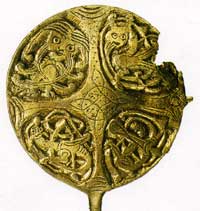 Gilt pin from Brandon
Gilt pin from Brandon |
|
780
|
Under King Offa the religious community at Brandon became wealthy. By this time their church and settlements were well constructed, and must have become well known. Like many other monastic sites, it began to attract wealthy donors.
A bronze key has been found, and some of the church windows were glazed. The Wilton Cross was very likely found not far from the Brandon religious site, and may have belonged to a wealthy patron, or possibly to a churchman of a status such as a Bishop. In Brandon itself there is a wood called Wiltonhill Wood, and Hockwold cum Wilton is just over the Wilton Bridge on the Little Ouse
The fine glass and metalwork found at Staunch Meadows in Brandon dates their times of most prosperity to the late 8th and early 9th centuries. Being located between Thetford and the Wash on the River Little Ouse meant that Brandon could participate in the trade going up and down these rivers, and benefit from passing travellers. Water traffic was also possible to Ely and Soham.
Examples of both Anglo Saxon Runic lettering and Latin alphabet usage has been found here, marked on various items. The evangelists were often depicted with animal symbols here. St John is depicted as an eagle, Matthew as a man, Mark as a lion and Luke as a calf. The pin shown here could illustrate this usage, but note that the central symbol is the cross, with 'maltese' type flared ends.
In 1978 an important gold plaque was discovered dedicated to St John and dated to the early 9th century.
Metalwork similar to the pins found at Brandon have also been found at Freckenham, not far from Exning and Soham. A gilt book mount has also been found. It seems that a literate and wealthy high status household was thriving there at this time.
|
|
786
|
Bishop Alhheard of Elmham and Bishop Heardred of Dommoc attended the Legatine Council of 786. This council met to ratify the 20 points of ecclesiastical and lay obedience being insisted upon by Pope Hadrian I. As King Offa had already given his assent, the Bishops from East Anglia, along with the rest, were obliged to accept as well.
|
|
787
|
Pope Hadrian I had been trying to assert papal influence in England, prompted by Charlemagne. King Offa, meanwhile, was asserting his own authority, and finding resistance from Kent, where the senior bishopric of Canterbury was located. King Offa therefore asked the Pope to establish a Bishopric in Lichfield, in the heart of Mercia. He now forced this on the Council of Chelsea in 787. Bishop Heardred of Dommoc, the East Anglian see, had attended these councils from Brentford in 781 to Chelsea in 787. His "reward" was to find that East Anglia was now annexed to the see of Lichfield by King Offa. Suddenly the East Anglian church was fully exposed to Offa's growing power. The see of Lichfield lasted until 803.
|
|
790
|
Because the coinage of East Anglia was being minted in the name of King Offa of Mercia, we do not know much about the succession of the East Anglian royal house during this period. East Anglian moneyers were Aethelwald, Ecgbald, Eadnoth and Earwerht, all minting for Offa.
King Aethelrad of East Anglia probably died during the 780's, and at some point he was succeeded by Aethelberht II.
Bishop Heardred of Dommoc died soon after 790, and was succeeded by Bishop Alfhun. Alfhun would later enter the Anglo Saxon Chronicle upon his death at Sudbury in 798.
|
|
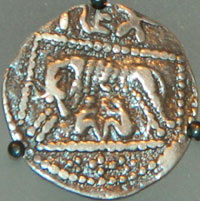
Silver penny of Aethelberht II
|
|
792
|
In about 792 Aethelberht appears in the coin record. A silver penny naming Aethelberht "REX" was minted by a moneyer called Lul. Not since Beonna in the 750's had any East Anglian dared to claim kingship on a coin. Not only this, but the coin also showed a wolf suckling two children, an allusion to Julius Caesar and the Roman Empire. Only the Wuffing dynasty of East Anglia had claimed to be descended from Caesar in their mythological genealogy. Aethelberht was clearly sticking his neck out, and this had grave consequences for him in 794.
Perhaps even Lul came in for retribution from Offa, as he also quickly seems to have issued another coin, identical to the first, except that Aethelberht was replaced by "Offa Rex". Offa even retained the wolf and children symbol.
|
|
793
|
There had been no significant attacks from the sea for 200 years, but in 793 the Danes appeared on January 8th and sacked Lindisfarne. Within a year Jarrow monastery was also attacked. The Anglo-Saxon Chronicles calls them "heathen men", and attributes no nationality to them, but they appear to have been from today's Norway.
On the continent the Emperor Charlemagne had been waging war on the pagan nations to the north of his Frankish lands. In 792 and 793 he had attacked Westphalia and Eastphalia. In about 783 he had been said to execute 4,500 Saxons for following their pagan ways at Verden. The Danes may be seen as fighting back against such religious oppression by attacking the religious sites of any Christian nation. This was known as Strandhewing, or attacking the shores, where their ships could easily reach, and then retreat from. Despite this attack the famous Lindisfarne Gospels have survived.
|
|
794
|
Aethelbert II, King of East Anglia, was killed at Sutton Walls, near Hereford by Offa, King of Mercia.
The Canterbury manuscript, Version F of the Anglo-Saxon Chronicle, recorded,
"792 - Here King Offa ordered King Aethelberht's head to be struck off."
The Peterborough manuscript, Version E of the Chronicle, gives the same statement, with the additional information that Offa was King of Mercia.
According to legend, Aethelbert was attending Offa's court at Sutton in Offa's Great Hall, and was treacherously murdered. The legend says that Aethelbert was seeking the hand of Offa's daughter, Elfthryth.
One interesting factor in the legend is quoted by Steven Plunkett. It is that the King's plan to marry into Offa's family was discussed with his thegns and explained to his mother, Queen Leofruna at Beodricsworth. In the Saints Lives of Aethelbert, his father is called Aethelred, and appears to be based at Beodricsworth as well. Beodricsworth certainly was regarded as a royal vill by these medieval hagiographers, but they were writing long after the events took place, and were far more interested in their parables of holy lives than in writing real history.
The plan to make a political alliance through marriage failed dismally. It seems that Offa felt that Aethelbert was challenging his control of East Anglia in some way, perhaps by minting coinage in his own name. Offa wanted to stamp out any opposition to his overlordship of Southern Britain.
So Offa had Aethelbert's head chopped off, and the body thrown in a swamp. Retrieved by his followers, the body was moved to Hereford. On the way, the head was lost and stumbled upon by a blind beggar whose sight was miraculously restored. Thus did King Aethelbert become a saint.
Meanwhile the story goes that Offa raised a large force and subdued East Anglia. As we have seen, none of this appears in the Chronicles.
Several churches were dedicated to St Aethelbert. One was dedicated in his name at Herringswell, and another at Hoxne, although the latter was supplanted by a dedication to St Edmund in the 10th century. St Aethelbert may have been succeeded by Eadwald as King in East Anglia, with Offa as his acknowledged Overlord.
|
|
796
|
The Great King Offa of Mercia died, having built Mercia up to control or influence all of England south of the Humber, including East Anglia. With the death of Offa, East Anglia started to assert some independence again, but this would take another 20 years to achieve.
In Mercia the kingship was taken up by Ecgfrith, Offa's son, but he died within a few months. Coenwulf, a descendent of Penda's brother, now became King of Mercia, and would rule that Kingdom from 796 to 821.
Coenwulf of Mercia continued to exercise overlordship of East Anglia. However, King Eadwald of the Eastern Angles now minted a certain amount of coinage in his own name.
|
|
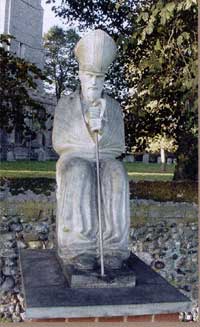
Saxon Bishop Aelfhun of Dommoc
|
|
798
|
The Anglo Saxon Chronicle recorded the death of a Bishop Alfhun at Sudbury in 798, and his subsequent burial at the headquarters of his Bishopric of Dommoc. This mention of Sudbury places it as one of the oldest recorded towns in the country. By this time St Gregory's at Sudbury was established as a minster, or church centre serving a wide area. To celebrate their 1,200 years of history, the town erected a statue of Alfhun on the Croft, by St Gregory's Church, in 1999. It was sculpted in 1998 by Alan Micklethwaite, a stone carver at Lincoln Cathedral.
Sudbury was an important river port on the River Stour. Sitting on the border with Essex, it controlled the river's headwaters, including Long Melford and access to the River Glem. As a burh it probably had a ditch and bank defence works, although these have not been found. With a church dedicated to St Gregory, it is one of the earlier establishments of Saxon Christianity. It may even date back to the time of Bishop Felix's first missions. Thus it was a town important enough to be visited by the Bishop, and important enough to be known to the scribes and thus to be named in the Chronicles.
After the death of Alfhun, his place was taken as Bishop of Dommoc by Tidfrith, who would rule the see until 816.
|
|
799
|
King Ecgberht became the ruler of East Anglia until 825 according to some sources and 836 according to others. All such dates have to be treated with caution.
|
|
800
|
After about the year 800, the climate improved somewhat, and the period from 800 to 1300 has been called the Medieval Warm period.
|
|
803
|
At the Council of Clofesho the Bishopric of Lichfield, set up under King Offa, was declared invalid. The premier Bishopric was again to be at Canterbury. King Coenwulf of Mercia had tried to get London made the major see, but this was rejected. In East Anglia, the see of Dommoc was thus freed from the overlordship of Lichfield. There seems little doubt that the church and the royal family of East Anglia were at this time working together to escape from Mercian control.
Bishop Tidfrith of Dommoc was accompanied at Clofesho by two abbots from his diocese, called Lull and Wulfheard.
All the Bishops now swore an oath of allegiance to the see of Augustine at Canterbury.
|
|
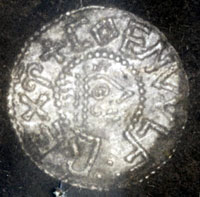
Coenwulf coin from Pakenham
|
|
815
|
This excellent example of a silver penny coin, with a "portrait" of Coenwulf, was found at Pakenham by a metal detectorist in the early 1970s. The moneyer was called WODEL and is thought to be from an East Anglian mint, showing that Mercia still had supremacy over East Anglia at this period.. The design is said to be from a later period of Coenwulf's rule. Its rarity is shown by the fact that it was for sale in 2012 for £2,950.
|
|
821
|
King Coenwulf, the king of Mercia, and overlord of East Anglia, died near the Welsh border. He was succeeded by his brother Coelwulf.
There were at least six minting sites in East Anglia during the reign of Ceolwulf, which lasted only two or three years. The sites are not named on the coinage, but the moneyers were as follows:
- Wihtred
- Hereberht
- Wodel
- Werbald
- Botred or Fotred
- Eadgar or Eacga
In about the same year Aethelstan may well have become King of East Anglia. Other authorities place his rule as beginning several years later, but only the coinage is available for interpretation. The date of 821 relies upon a ship type penny minted by Eadgar for Aethelstan, now in Norwich Museum. King Aethelstan would rule in East Anglia until 845, and at first he was subject to the Kings of Mercia.
|
|
823
|
King Coelwulf was deposed as King of the Mercians. He was replaced by King Beornwulf, who immediately claimed his rights over East Anglia. Roger of Wendover even claimed that Beornwulf had made such a claim since the days of Offa. If so, he presumably felt he had some dynastic claim in his own right.
|
|
824
|
We know that Bishop Wermund had now succeeded to the Bishopric of Dommoc as he attended a Council at Clefesho in 824. His predecessor Tidfrith was last on record in 816.
|
|
825
|
Aethelstan was probably by now King of East Anglia but some sources date this to as late as 836. He was under the control of Beornwulf of Mercia, but was determined to break free of Mercian overlordship, a struggle which had been going on for several years by various, mainly political, means.
The Anglo-Saxon Chronicle, Manuscript A, for 823 (825) stated:
"that same year the King of the East Angles and his folk sought King Ecgberht as their protector and guardian against Mercian terror, and that same year the East Angles slew Beornwulf, the King of the Mercians."
This implies an alliance between the King of East Anglia and the King of Wessex against their joint enemy of Mercia.
Ecgberht had been king of the West Saxons for 21 years, and had resisted attempts by Mercia to bring Wessex into their control. In 825 Beornwulf of Mercia attacked Ecgberht's army at Ellandun near Swindon. Boernwulf came off worst, and Ecgberht now attacked Kent, intending to make Wessex the new Overlord of England. Kent, Sussex, Surrey and Essex now submitted to Ecgberht.
It seems that King Aethelstan of East Anglia now sought Ecgberht's support for his own uprising against Mercia. Beornwulf probably attacked East Anglia to enforce his overlordship, and in the process was killed as detailed in the Chronicle.
Perhaps merely by coincidence the Bishop Wermund of Dommoc was replaced by Bishop Wilred in 825. He would be Aethelstan's Bishop for many years. The Bishop of Elmham at this time was Bishop Hunferth, later to be replaced by Hunberht.
King Beornwulf of Mercia was succeeded by one of his ealdorman, a man called Ludica. Some of the East Anglian moneyers continued to strike coins for him, so the East Anglians still acknowledged Mercian power.
|
|
827
|
Ludica, king of the Mercians, was killed along with his five leading ealdormen. Roger of Wendover wrote that this was by order of King Ecgberht of Wessex.
From 827 the East Anglian moneyers produced no further coins for Mercia in the name of Wiglaf, who now took over in Mercia. On the contrary, the East Anglians now began to produce coins for their own local king Aethelstan, who now enjoyed Ecgberht's support.
Control of the English would now slowly pass from Mercia to Wessex, but East Anglia was now free from Mercian dominance. This produced a new confidence on the southern borders of East Anglia. Along the Stour the town of Sudbury found itself on a friendly border, well away from the coast and the threat of the Danes. Hadleigh is obscure at this time, but was probably well in existence, which would have led to it becoming the seat of Guthrum the Dane who would be buried here in 891.
|
|
829
|
King Wiglaf or Mercia was not going to accept East Anglian independence without a fight. He probably attacked East Anglia. However, King Ecgberht of Wessex was prepared to help anybody against Mercia, and saw this as a chance to strengthen his own position. He attacked Wiglaf and defeated him. At Crowland Abbey there is a story that the defeated Wiglaf sought refuge in that Monastery for four months after his defeat.
Ecgberht went on to conquer Northumbria.
|
|
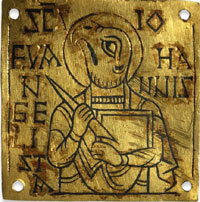
St John Plaque from Brandon
|
|
830
|
The monastic foundation at Brandon was at the height of its prosperity at this time. This gold plaque was found by a fisherman by the River Ouse at Brandon in 1978. It comes from what was a high-status Saxon settlement with strong religious connections.
The British Museum description of this piece is as follows:
"The square of gold is finely engraved and inlaid with black niello. The powerful image is of an unusual figure with the body of a man dressed in robes and holding in his hands a quill pen and book, and the head of a fierce eagle. A Latin inscription reading SCS EVANGELISTA IOHANNIS ('St John the Evangelist') fills the space around the figure. This explains the eagle-head, because the eagle is the symbol of St John, Evangelist and writer of one of the Christian Gospels. The book and pen also represent his Gospel.
Holes at the four corners suggest that the plaque may have been set into a standing cross or onto a book cover. The plain back has a small letter 'a' as a guide for assembling the original object. This plaque will have once been part of a set of four, with three more depicting the symbols of the other three Gospel writers, the Evangelists St Mark (a lion), St Matthew (a man) and St Luke (a bull).
The mix of man and symbol is clever and unusual, while the lettering is of high quality. It is a unique survival in metal of the kind of decoration found in the finest manuscripts of the period. "
This type of book decoration was typical of monastic foundations at the time. It is likely that Sigeberht's royal monastic foundation at Bedericesworth would have been the equal to the Brandon site.
The defeated King Wiglaf of Mercia managed to re-establish his position as King of Mercia, but his control over East Anglia was broken, and he never tried to conquer it again.
|
|
831
|
In the heroic poem "Beowulf", the hero has a companion called Wiglaf. The poem includes reference to Offa of Angeln. In 1982 James Campbell suggested in "The Anglo Saxons", that the poem originated in Mercia around this time at the court of Wiglaf. Sam Newton's "Origins of Beowulf" contradicts this idea, pointing out the many more affinities with the Wuffings and the Sutton Hoo and Snape ship burials of East Anglia.
Beornwulf himself king of Mercia from 823 to 825 also seems to have had a claim to East Anglia in his own right. Steven Plunkett has suggested in "Suffolk in Anglo Saxon Times", that Beornwulf may have been part of a 'B' dynasty in East Anglia, tracing back through King Beonna, perhaps even to Beodric of Beodricsworth. This idea relies upon the propensity for royal families to use the same initial letter in naming their offspring as themselves.
However, these ideas must be only speculative, and we should not be surprised when widely known songs and poems are given a local flavour by the performer of the moment. Folk songs frequently show local modifications to suit local audiences in more recent centuries.
|
|
832
|
In 832 Archbishop Wulfred of Canterbury died, to be succeeded by Archbishop Coelnoth who ruled the see of Canterbury until 870.
By now many better off secular people were wearing tunics with decorated strap ends, indicating a degree of comfort better than subsistence living. These strap ends occur widely in Suffolk, but better ones are found at supposed centres of trade and enterprise. These include Badwell Ash, Ixworth, Icklingham, Freckenham and Brandon. Spurs have been found at Icklingham, Pakenham and Yaxley. We must be cautious about interpreting this distribution too rigidly, as, like all archaeology, it will reflect to some extent the distribution of "digs" and of modern observers.
|
|
835
|
Since 793 the Vikings had sporadically raided Irish and Continental coasts but in, and after, 835 many more hit and run raids were carried out on England, up to 15 miles inland. Danes mainly raided Southern England, and the Norsemen attacked the North, even establishing a capital at York, but these were part of a much bigger expansionist movement which also reached Iceland and North America, Russia and Spain.
By this time Christianity had been well and truly established in East Anglia. It had taken root over two centuries, and replaced the old belief in Woden as the ancestor of the English Angles and Saxons. As Steven Plunkett put it,
"The coming of Christianity had effected changes in arts, law, urban life, literacy, organised commerce, statehood and ecclesistical structures, all embedded in the East Anglian state."
The coming of marauding armies of pagan Danes was in total contrast to their new settled existences. Queen Seaxburh's double monastery at Sheppey, in Kent, was devastated by Danish looters in 835, having stood since she founded it around 673. Seaxburh had been the daughter of King Anna of East Anglia, so the loss of this minster would have been keenly felt in East Anglia, as well as in Kent.
|
|
836
|
In 836 an attack by 25 shiploads of Danes was made near Minehead in the Bristol Channel. King Ecgberht of Wessex, who opposed them, lost large numbers of men.
|
|
838
|
A great host of Danes landed in Cornwall, and here they apparently joined with the British to fight against Ecgberht of Wessex who moved against them. This time Ecgberht was judged to be the winner.
These raiders now worshipped Odin, a revised form of Woden, the god of earlier centuries. They also attacked the continent, raiding Dorestad, Ipswich's continental trading partner, several times. The Frankish and Irish coasts were also looted.
|
|
839
|
In this year Ecgberht passed away having reigned 37 years. His son Aethelwulf became King of Wessex, but he gave his grandson Aethelstan the thrones of Kent, Essex, Surrey and Sussex. There are coins of the 820's to 840's which also give the name of Aethelstan as King of East Anglia, and some historians have suggested that these were the same person. Others believe that Aethelstan was the brother of Aethelwulf, rather than his son. For example, according to "L'Estoire des Engleis' by Geffrei Gaimar, the King of East Anglia at this time was Aethelstan, the brother of King Aethelwulf of Wessex.
These dates and ideas are continually subject to revision by historians but whether Aethelstan was given East Anglia prior to his father's death, or whether there were two men of the same name, seems unknowable at present.
Whatever his origins, the King of East Anglia was called Aethelstan at this time, and during the 830s his coinage included the words 'REX ANG', or King of the Angles.
The East Anglian Bishops were Hunberht of Elmham and Wilred of Dommoc. Both men attended the Bishops' Council of Astran in 839. Like the location of the church councils at Clofesho, we do not know the location of Astran.
|
|
840
|
Vikings struck twice on the Wessex coast. At Hamwih they were driven off with great slaughter, but at Portland the Dorset army was defeated and their ealdorman was killed.
|
|
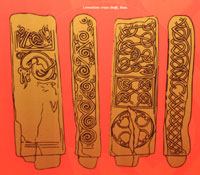
Cross shaft at Iken
|
|
841
|
Viking raiding parties hit Lindsey, East Anglia and Kent. Others landed at Dublin, and Rouen was sacked. The Chronicles say that many men were slain by the assault of the host on East Anglia.
Ipswich and Norwich may have been targets for these attacks in East Anglia. All of the coastal monasteries like Dommoc and Iken, with their valuable trappings donated by the faithful, must have been vulnerable, and too numerous to be properly defended when attack came from out of the blue.
The burial grounds at Sutton Hoo and Snape, along with the royal households at Rendlesham and surrounds, must have feared attack, but we can only guess whether such attacks occurred.
Burrow Hill in Butley seems to have been abandoned around this time. By the 940s the area known as the Wicklaw was no longer run from Rendlesham, but from Sudbourne. So it may be that these raids caused this move to occur.
No trace remained of the well established monastery at Iken until 1972, when Dr Stanley West was excavating around the church at Iken. He discovered and identified the shaft of a 9th century cross which had been re-used in the fabric of the later church. It may be that the cross was erected following an attack by the vikings and the destruction of the minster. It was the practice to mark a site where a church and altar were removed by the erection of a cross. The Iken Cross was very unusual for East Anglia. It was probably brought from Mercia, and was carved on all four faces, and originally 3 metres tall. Earlier wooden walls were found below the Norman walls, together with remains of severed limbs. St Botolph's remains continued to lie at Iken until the late 10th century.
|
|
842
|
The inhabitants of London, Rochester and Hamwih were next to suffer murderous attacks by the Danes. Across the channel the Frankish port of Quentovic was plundered.
|
|
843
|
King Aethelwulf personally led an army to resist a Danish force at Carhampton, near Minehead, but the English were defeated, despite being on home ground.
|
|
845
|
At some point around this time, King Aethelstan was succeeded as King of East Anglia by Aethelweard. It may be that the East Anglian Aethelstan had died. But if he was the same man as the Aethelstan who became King of Kent in 839, then he may have handed the defence of East Anglia to Aethelweard around 842. East Anglian coinage now featured Aethelweard as 'REX' until about 855.
In Northumbria a civil war had resulted in a viking attack against the disunited Nothumbrians and many men were killed. Clearly the English kings needed to stand firm together if they were to have any chance to resist these raids.
Archbishop Coelnoth called the Bishops to London to discuss the present dangers. The East Anglian Bishops, Wilred of Dommoc and Hunberht of Elmham, both attended the meeting.
|
|
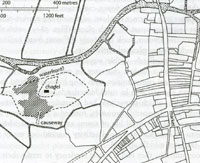
Site of Brandon minster
|
|
849
|
By about 850 it seems that the thriving monastic institution at Brandon, located in Staunch Meadow, was abandoned. The site was surrounded by marsh and water, reached by a built up causeway. The town grew up to its east side, and the site reverted to grazing marsh. A later chapel marked the site. Excavations on this site do not reveal a Viking destruction, but rather, one of those shifts of settlement which seem to have occurred in Saxon times. The new site was probably more comfortably away from the marshes, and their periodic floodings.
|
|
850
|
By 850 the population of East Anglia seems to have grown enormously. Good agricultural land had favoured the Anglo-Saxon farmers, but now there were many people to compete for grazing rights on the common lands. It has been suggested that this competition for access to common land has led to "common edge settlement drift". Farmers may have actually been ready to move out of their existing settlements to "stake a claim" to some part of the commons. This would lead to a string of small dwellings along the edge of the common, perhaps even leaving behind an existing established church with few, if any, dwellings left around it. This process seems to have started in East Anglia well before it occurred elsewhere in the country.
By the mid 9th century the town of Ipswich was huge, at about 125 acres, and was only a little smaller than the area later to be encompassed by its medieval walls. Ipswich at this time has been called the largest known early trading community in north-west Europe. East Anglia and its royal family would have been rich, famous and powerful.
While Ipswich was East Anglia's primary commercial and Industrial centre, as well as a nationally important port, its presence promoted prosperity throughout East Anglia. Town like environments were growing up at Beodricsworth as well as at Thetford and Norwich. While Ipswich was Gipes' Wic, Norwich was the North Wic of the kingdom.
The main industry of Ipswich was pottery, which was sent throughout central and eastern England. Ipswich ware was better than available elsewhere, and its production was also being continued in Thetford. The next 50 years would be good ones for Ipswich Ware sales.
The Viking peril remained strong. In 850 Devon had to fight off an attack. But forces were being gathered to attack Kent in greater numbers. This year the vikings did not return home at the end of the raiding season. They spent the winter on the Isle of Thanet. Almost certainly they sacked the monastery of St Mildred there. |
|
851
|
For the first time the Vikings had over-wintered in England. By the end of winter they had gathered 350 shops and up to 6,000 men to launch a major attack up the River Thames. They 'ruined Canterbury', and attacked London, causing great carnage and putting King Beorhtwulf of Mercia to flight.
The invaders now attacked Surrey, but were met by the army of Wessex led by King Aethelwulf and his son Aethelbald. Large numbers of the invaders were killed. In their retreat one party was attacked by King Aethelstan of Kent in ships off Sandwich.
This over-wintering continued and would lead to eventual take-over in future years.
|
853
|
Ealdorman Ealhhere of Kent was killed in further fighting with pagan invaders at Thanet.
|
854
|
In 854 the Danish host was back in Kent. Once again they spent the winter in England. This time it was on the Isle of Sheppey.
By now King Aethelstan of Kent was probably dead and
|
| |
|
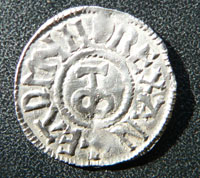
King Edmund Penny
|
|
855
|
King Aethelweard of East Anglia must have died in 855. He was succeeded by King Eadmund, eventually to become known as St Edmund, King and Martyr, and to have St Edmund's Bury or Bury St Edmunds named in his honour.
From 855 to 870 Edmund's coinage was in circulation with his name on them. Spink's Coins of England states that one side had an Alpha or A, and the reverse had a cross with pellets or wedges. The coin shown here appears to show Omega rather than alpha. J North in English Hammered Coinage Volume 1 does give an example similar to the illustration here, describing it as very rare for King Edmund. The motif is described as omega with latin cross.
The inscription reads "EADMUND REX AN", REX AN being short for REX ANGLORUM, or Edmund King of the Angles.
Wealthy and important men who struck coins for the king are known as moneyers, and the moneyers known for Edmund are:
- Eadberht
- Eadwald
- Eadmund
- Ethelulf
- Sigered
- Baeghelm
- Beornferth
- Beornhaeh
- Dudda
- Twicga
We can see that it is easily possible to become confused with the memorial coinage issued after 885 or so by Aethlred I of Wessex and King Alfred, and in Danish East Anglia some years after Edmund's death as a martyr. Examples of the later memorial coins also show the design of the 'alpha'.
King Edmund would rule East Anglia until his execution in 869 when the country was finally over-run by Danish invaders. There is a great deal of written material about King Edmund, but much of the detail was added long after his death. The growth of the Legend of St Edmund, King and Martyr,is covered fully elsewhere in this history.
In West Mercia the Danes attacked around Wroxeter during the summer. All the English kings knew that they had to deal with the Danes as a major part of their responsibilities.
King Aethelwulf had been king of Wessex since 839, but following his absence and a foreign marriage, in 855 it was agreed that he would rule Kent, Essex, Surrey and Sussex. His son Aethelbald now ruled Wessex. These kings were Edmund's neighbours and a peaceful co-existence lasted for the next ten years. East Anglian border towns like Haverhill and Sudbury would continue to flourish in these circumstances.
|
856
|
According to the Annals of St Neots, an early 11th century record, King Edmund was crowned King of East Anglia at Burum, usually translated as Bures, another border town. The Annals say that he was crowned exactly one year following his accession.
His anointing seems to have been carried out by Bishop Hunberht of Elmham, who was presumably the senior figure in the East Anglian church. Bishop Wilred of Dommoc was the other East Anglian Bishop at the time.
|
|
|
Quick links on this page
Top of Page 410
Saxons take over 442
Arthur leads resistance 470's
Battle of Badon 495
Gildas writes History 538
London and St Albans fall 570
Raedwald rules 599
Sutton Hoo burial 625
King Sigbert sponsors Felix 631
St Audrey's Ely nunnery 673
South Elmham Minster 680
Beowulf written 710
Bede writes History 731
Vikings sack Lindisfarne 793
|
|
865 on
|
In 865 the Anglo-Saxons of England suffered a major disaster with the invasion by the Great Army or host of the Danes. We date the late Saxon period from this invasion and if you wish to follow the story of English and West Suffolk History into the time of the Viking Invasion, please click here.
|
Prepared for the St Edmundsbury Local History Project
by David Addy, July 1998 to December 2002
Revised and improved 2006 and 2007
Reference Books
John Morris - Roman Britain and the Empire of Arthur
Stanley West - Understanding West Stow, et al
Geoffrey Ashe (ed) - The Quest for Arthur's Britain
Michael Swanton (trans) - The Anglo-Saxon Chronicles
Ann Savage (trans) - The Anglo-Saxon Chronicles
Norman Scarfe - The Suffolk Landscape
Sam Newton - The Origins of Beowulf
Sam Newton - The Reckoning of King Raedwald, 2003
Dr Sam Newton's Wuffing website. www.wuffings.co.uk
Haverhill Local History Group - A Walk Around Haverhill
David Dymond and Peter Northeast - A History of Suffolk
David Dymond and Edward Martin (ed) - Historical Atlas of Suffolk
R Bond, K Penn & A Rogerson - The North Folk
Steven Plunkett - Suffolk in Anglo Saxon Times, 2005
The Church in Anglo-Saxon Society by John Blair, 2005
|
























































